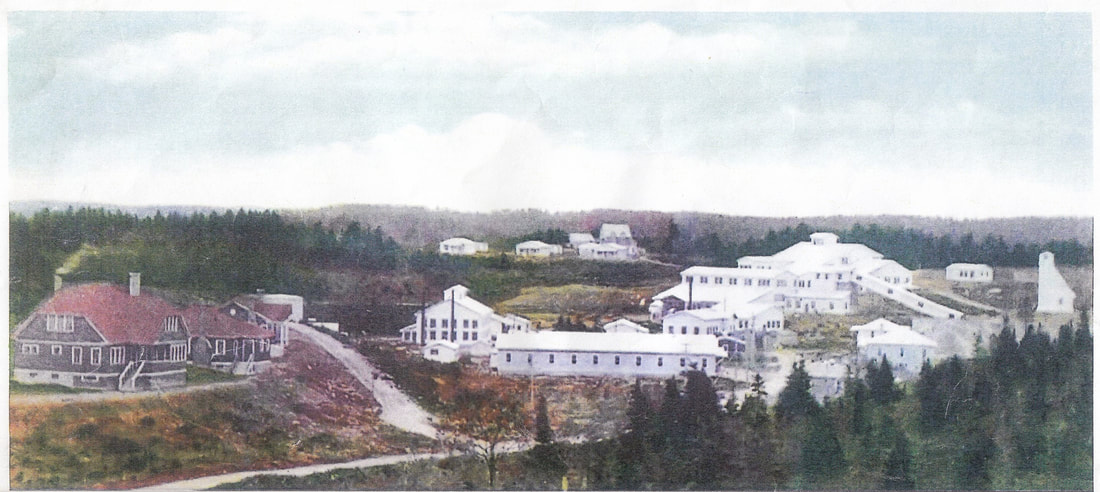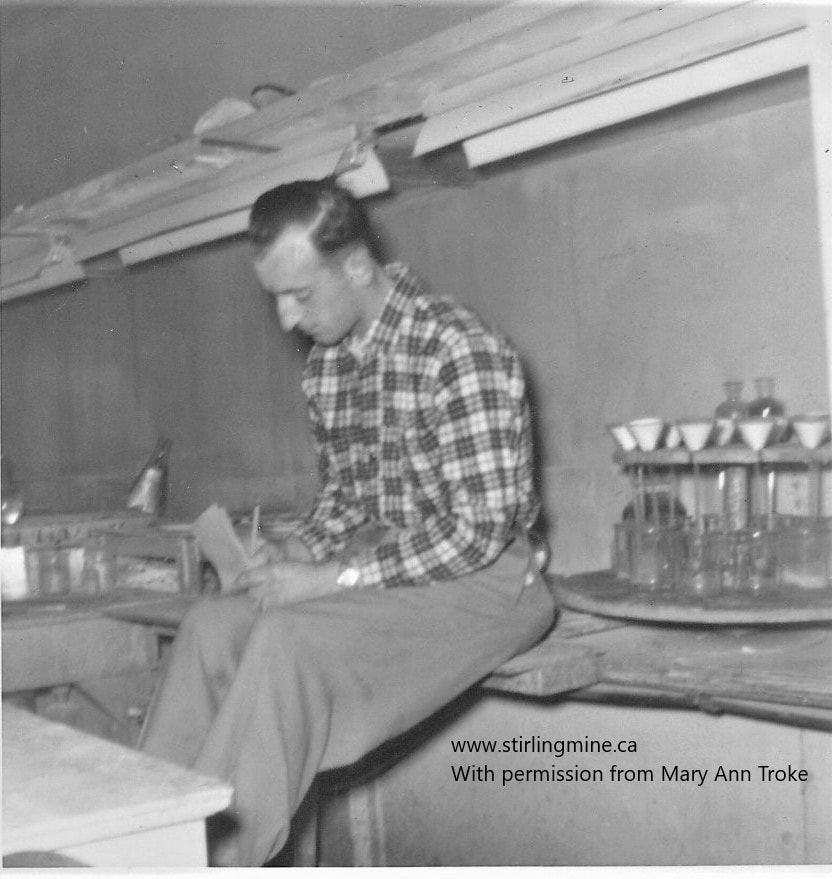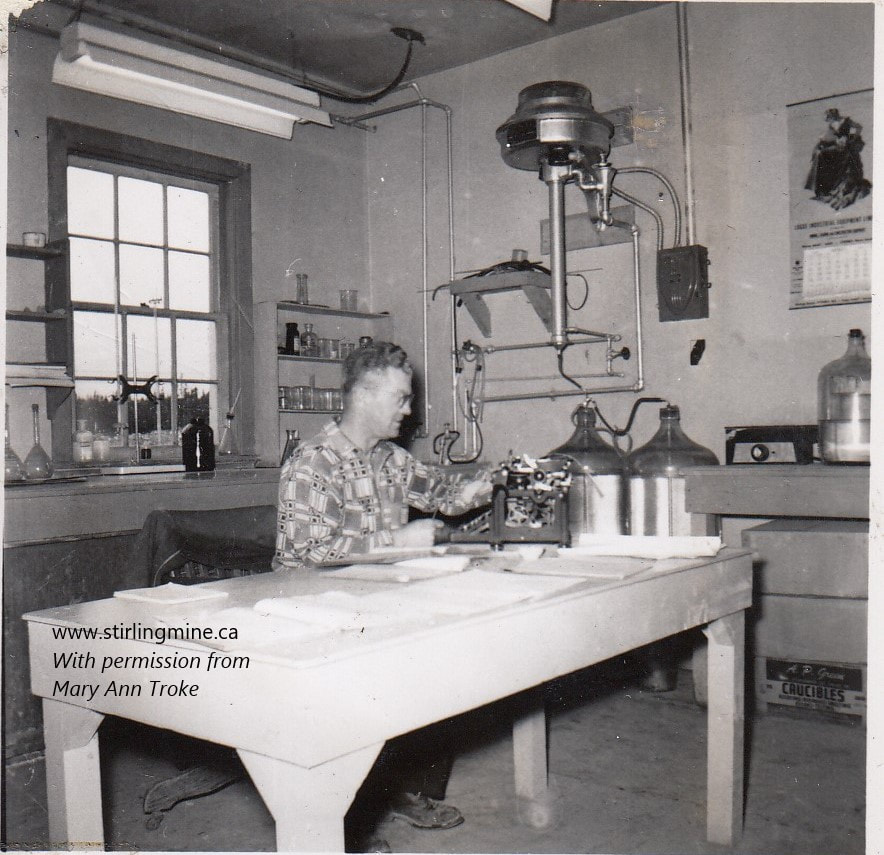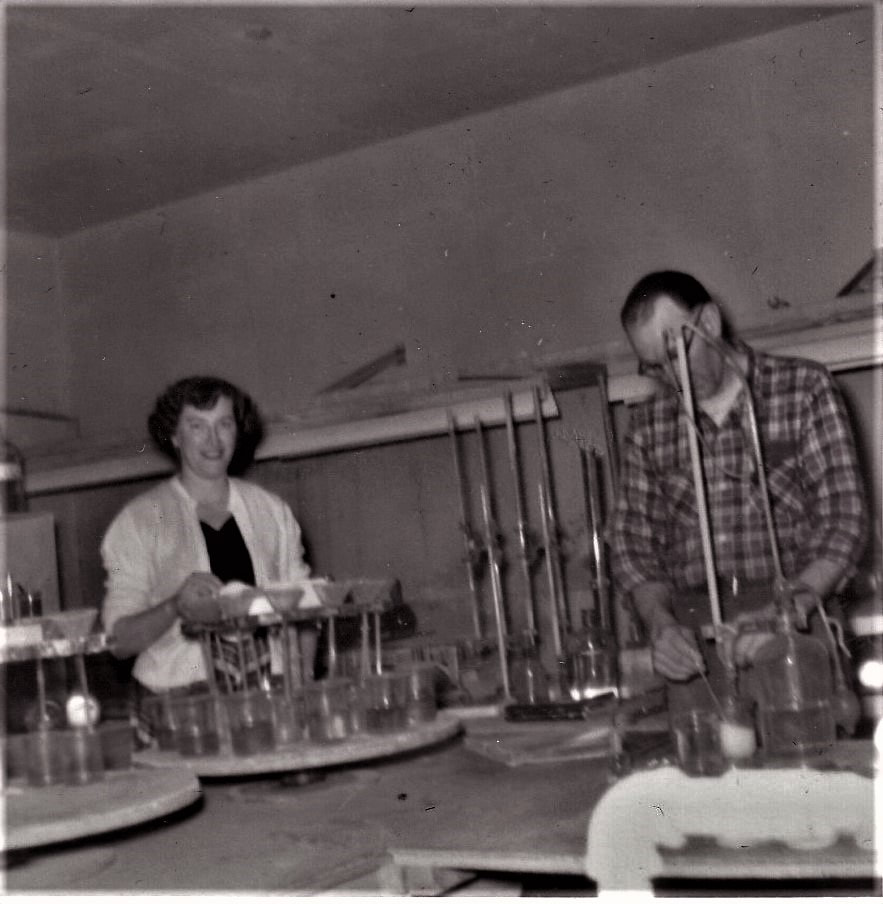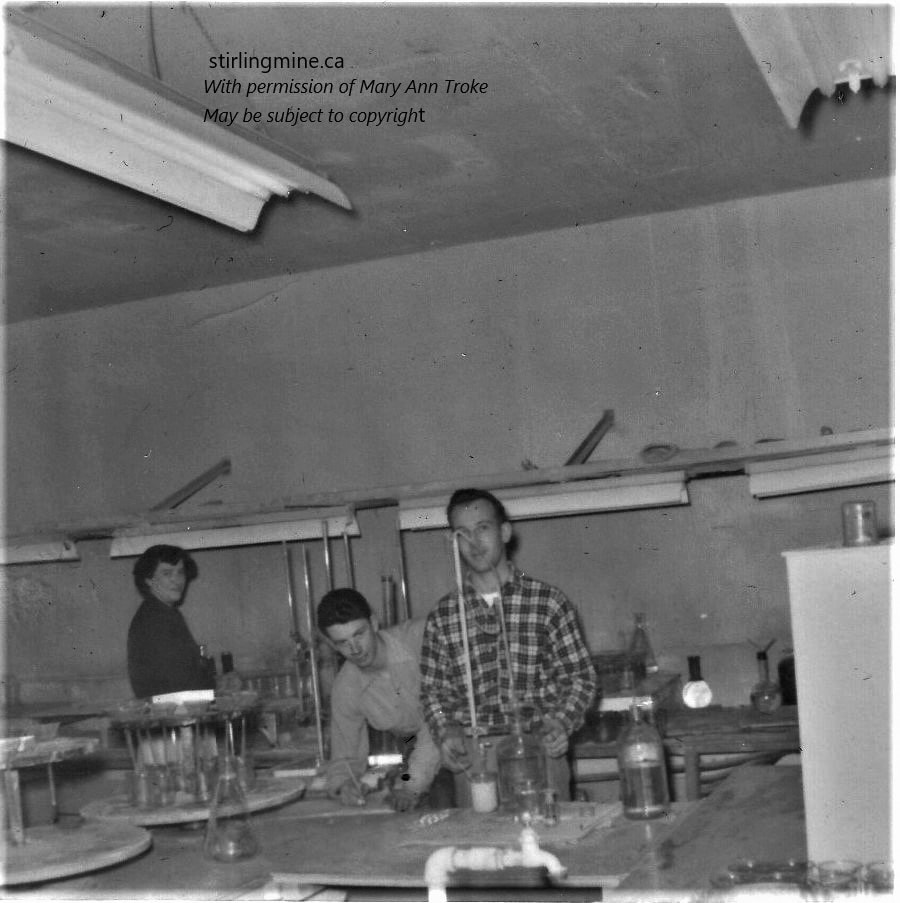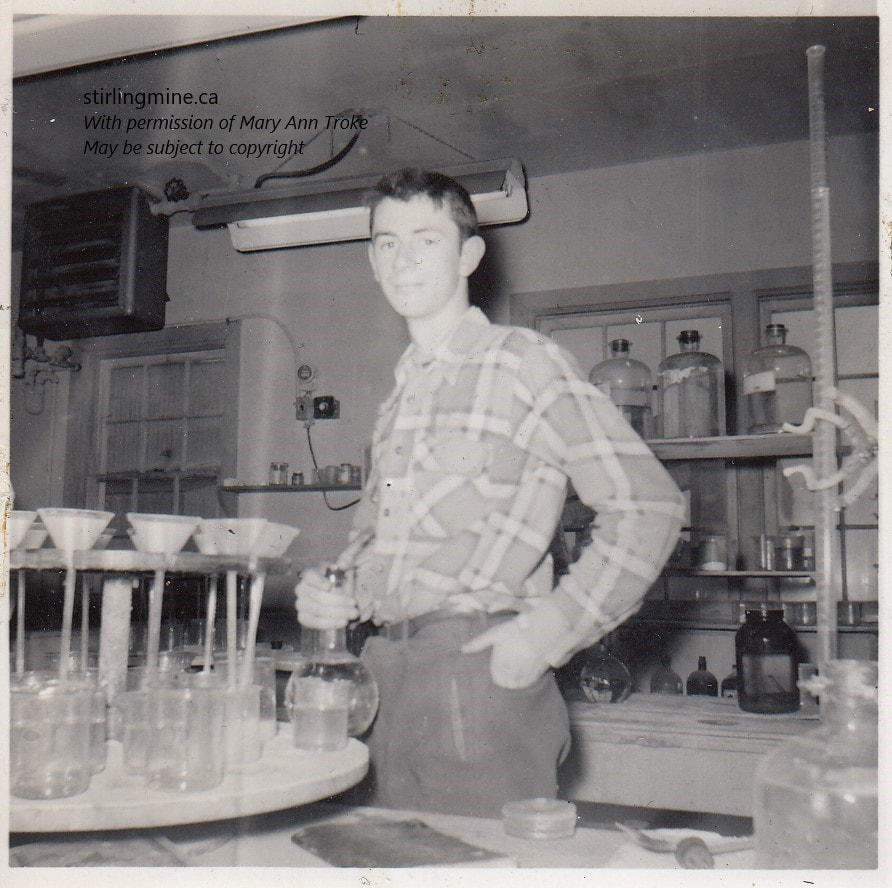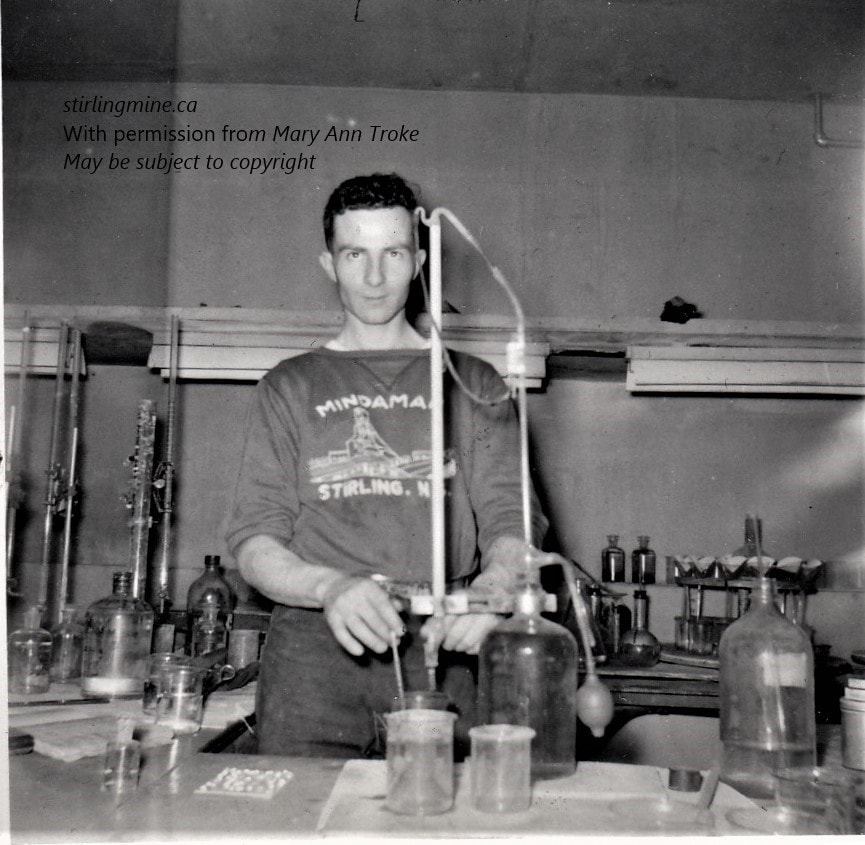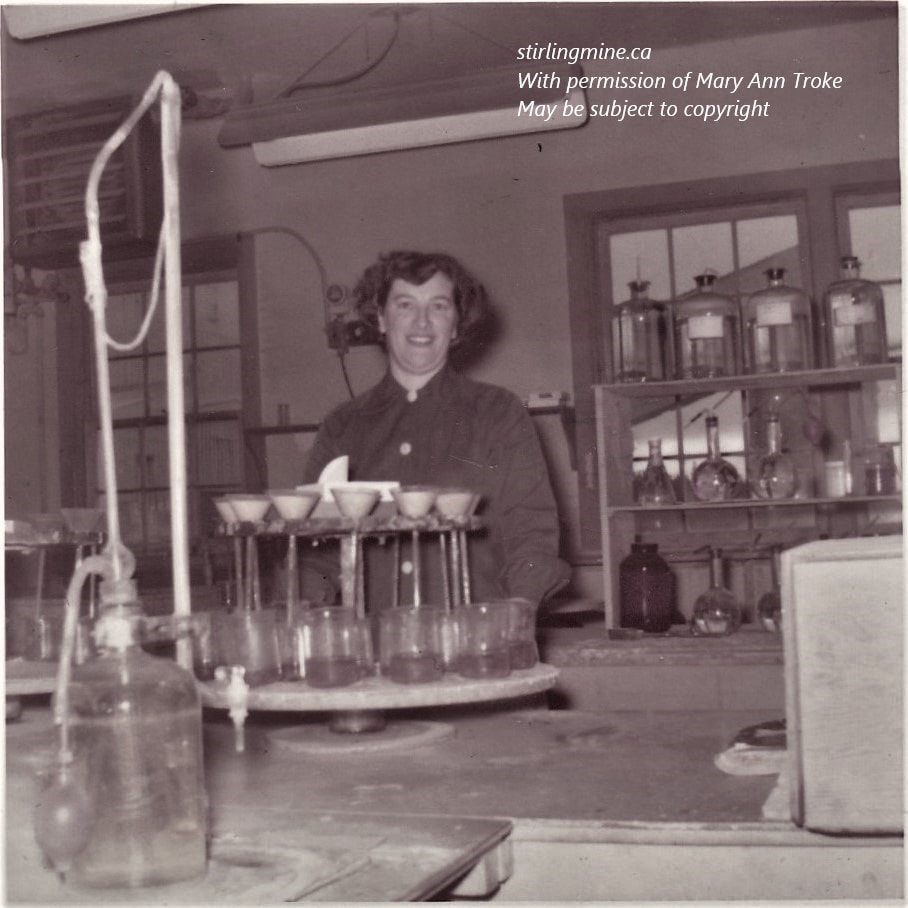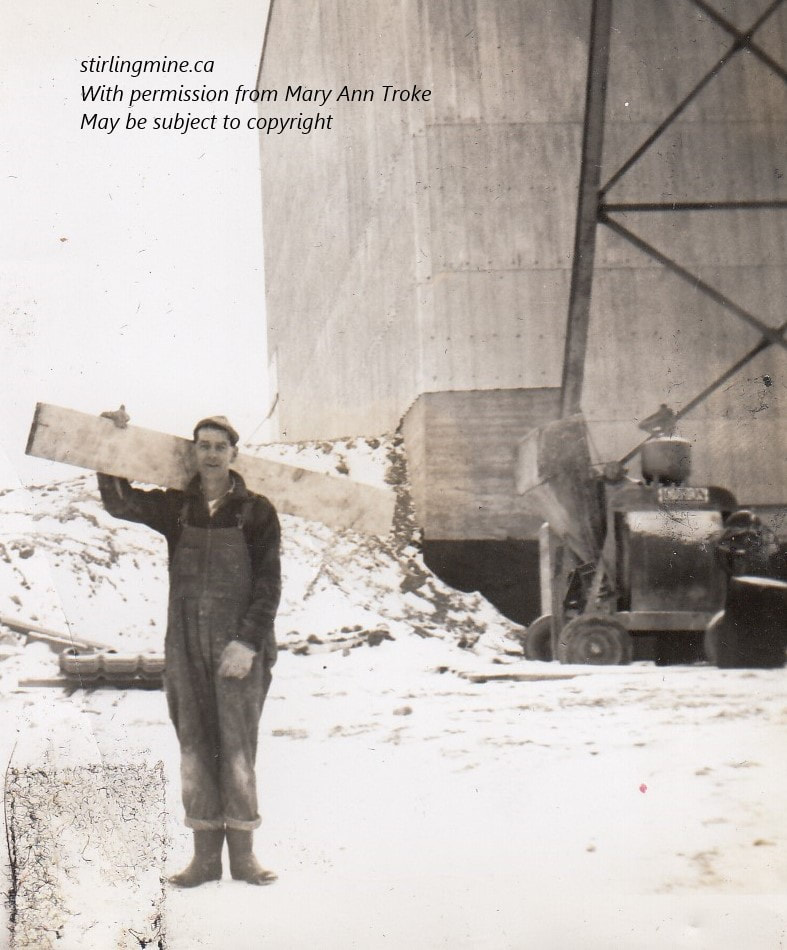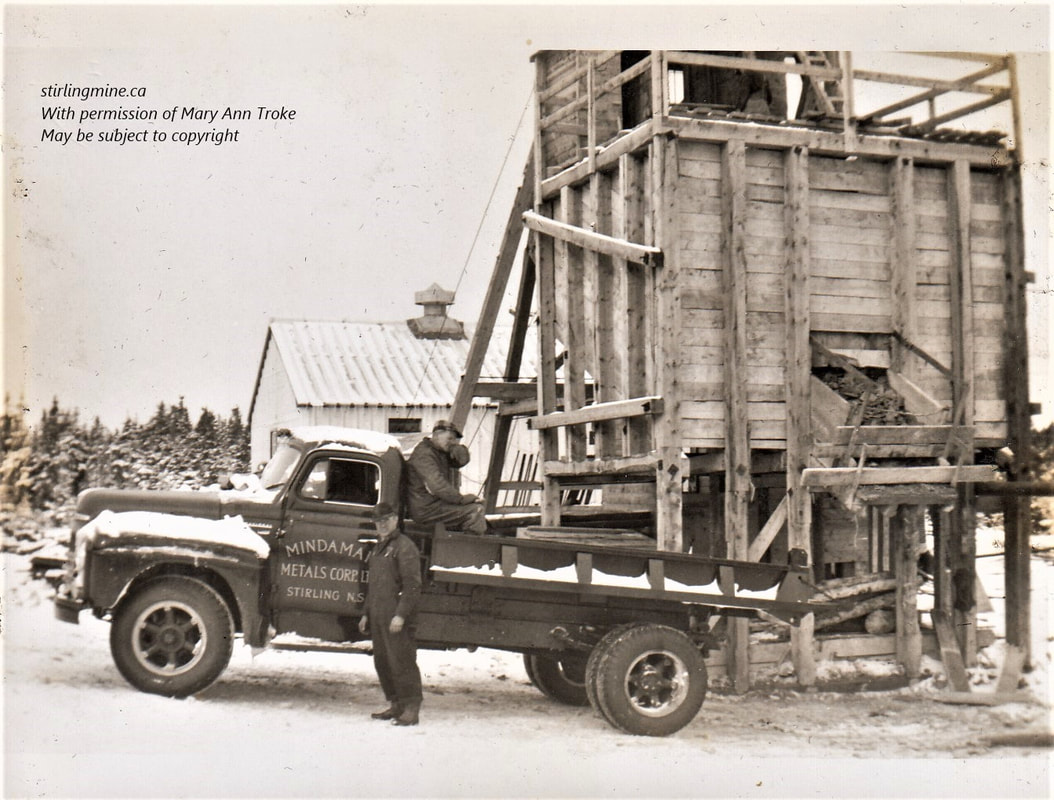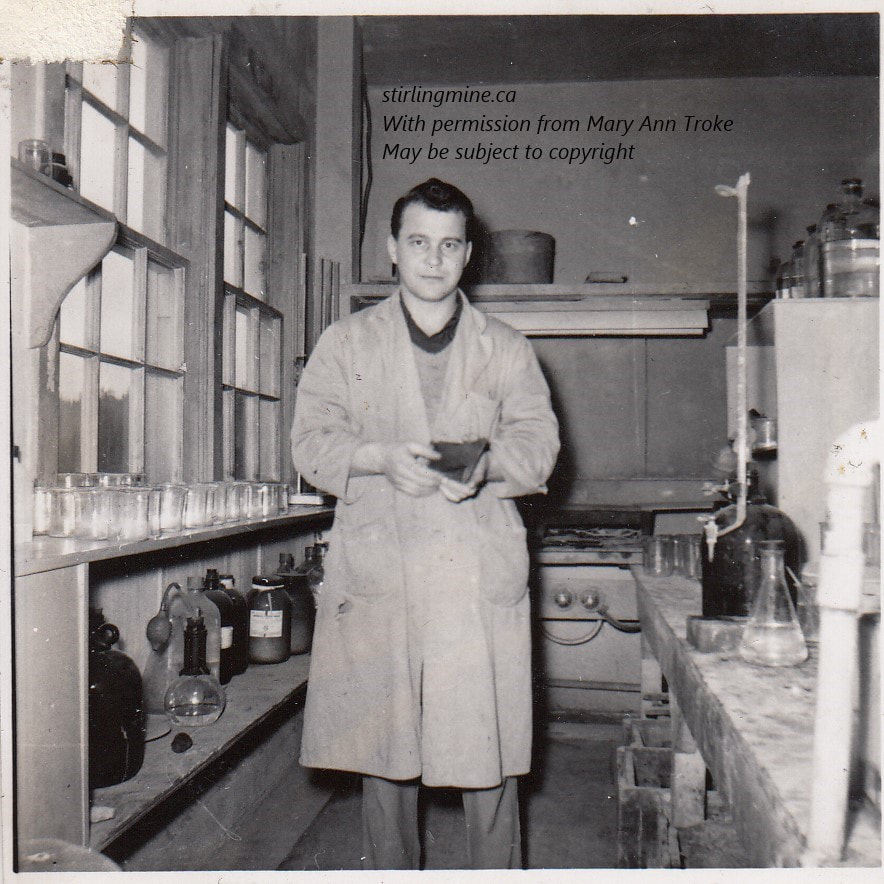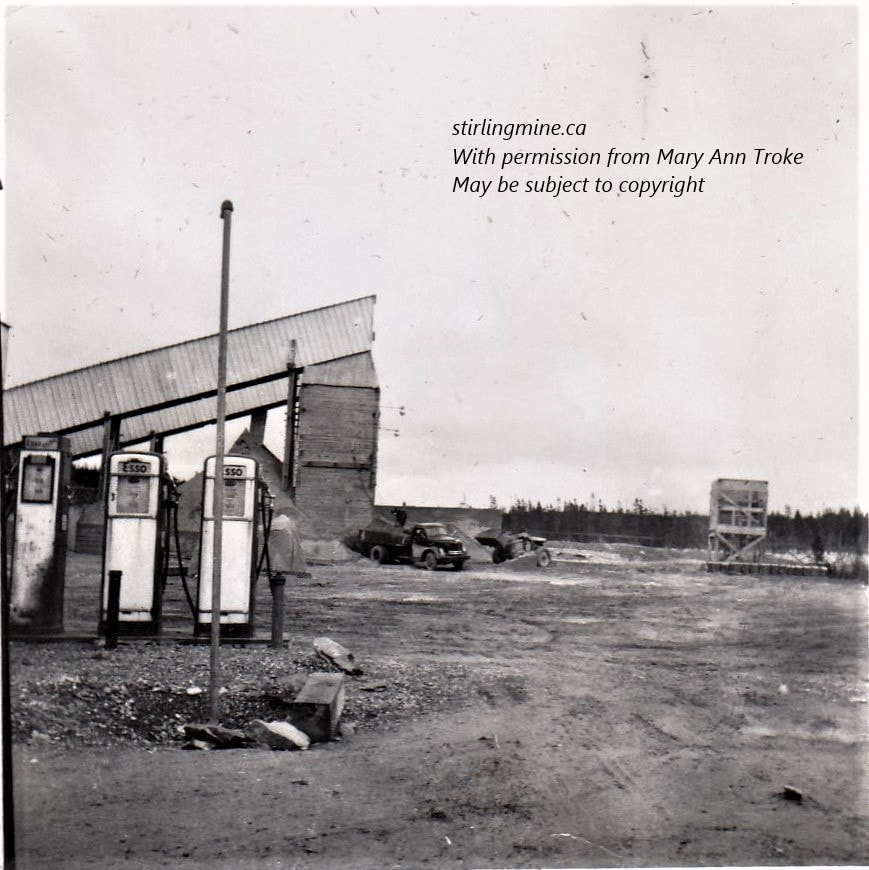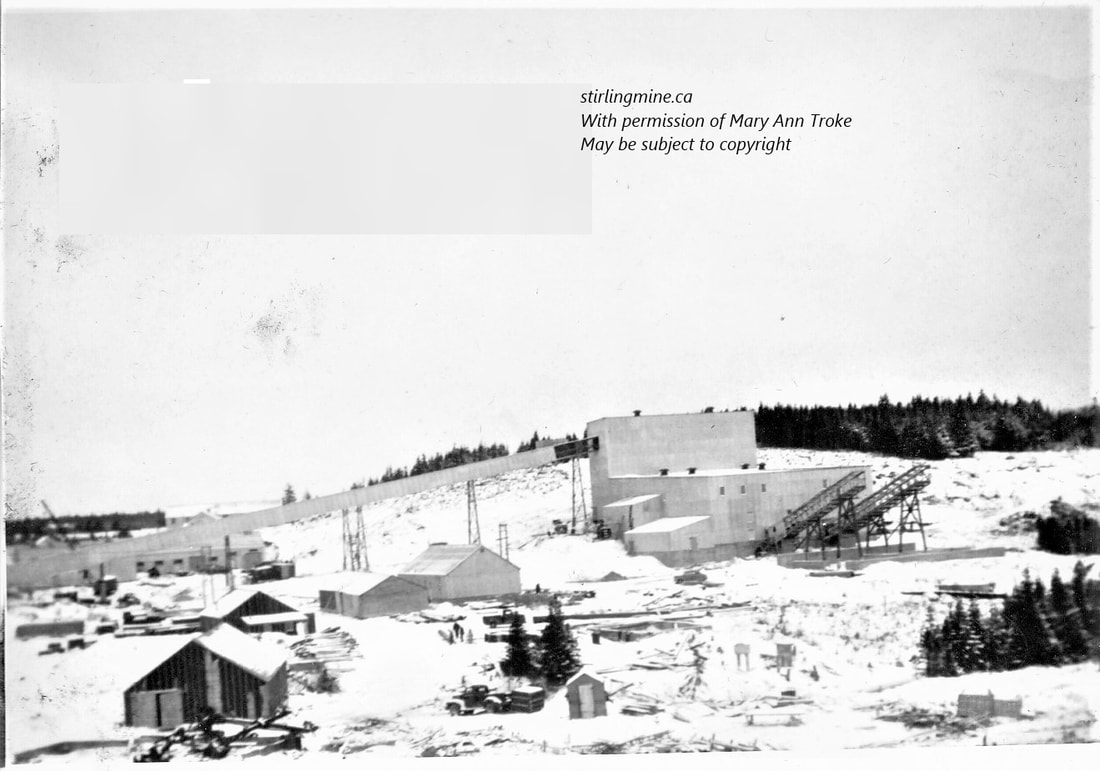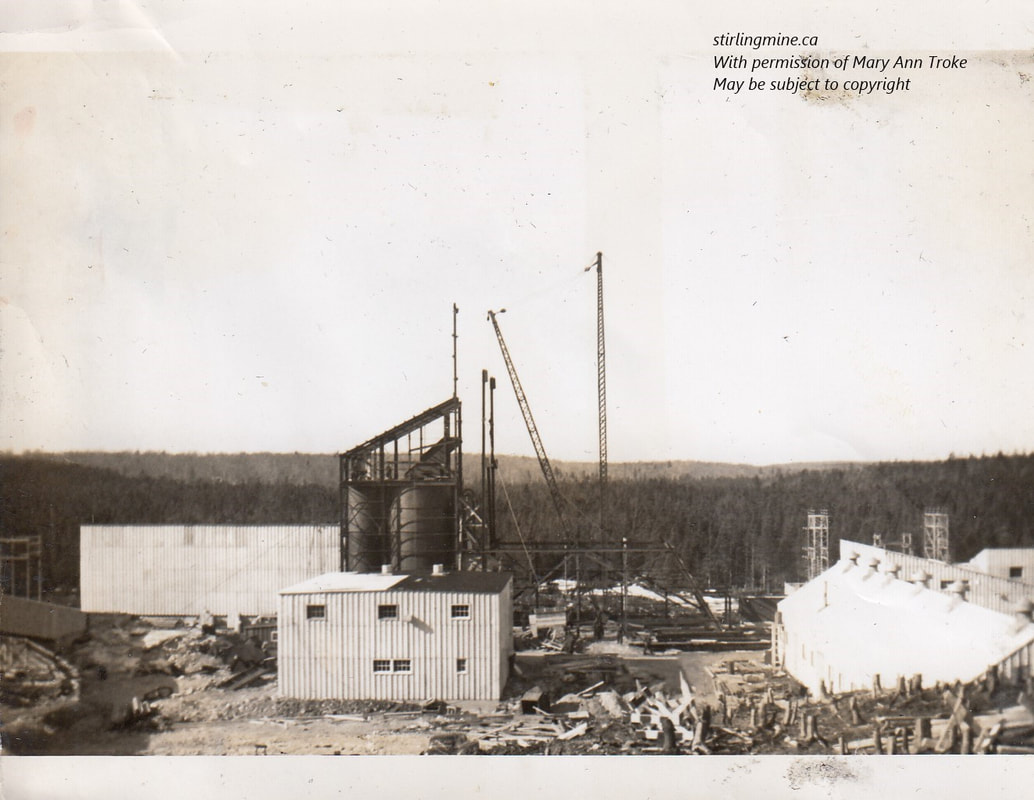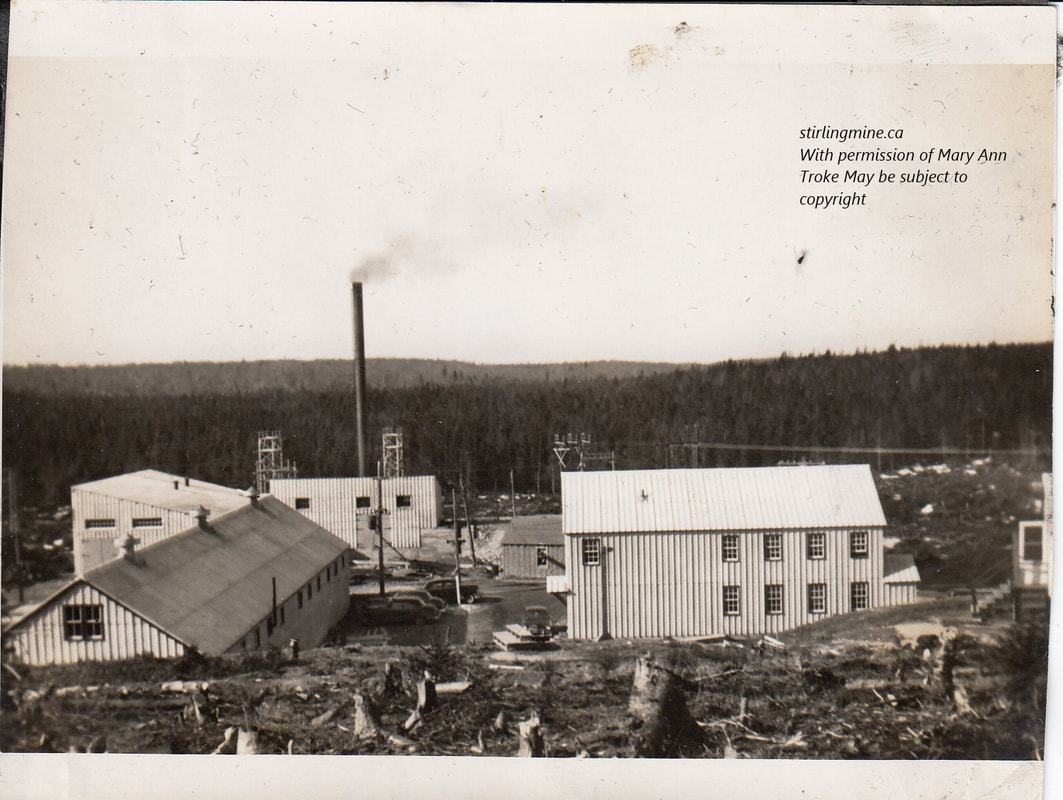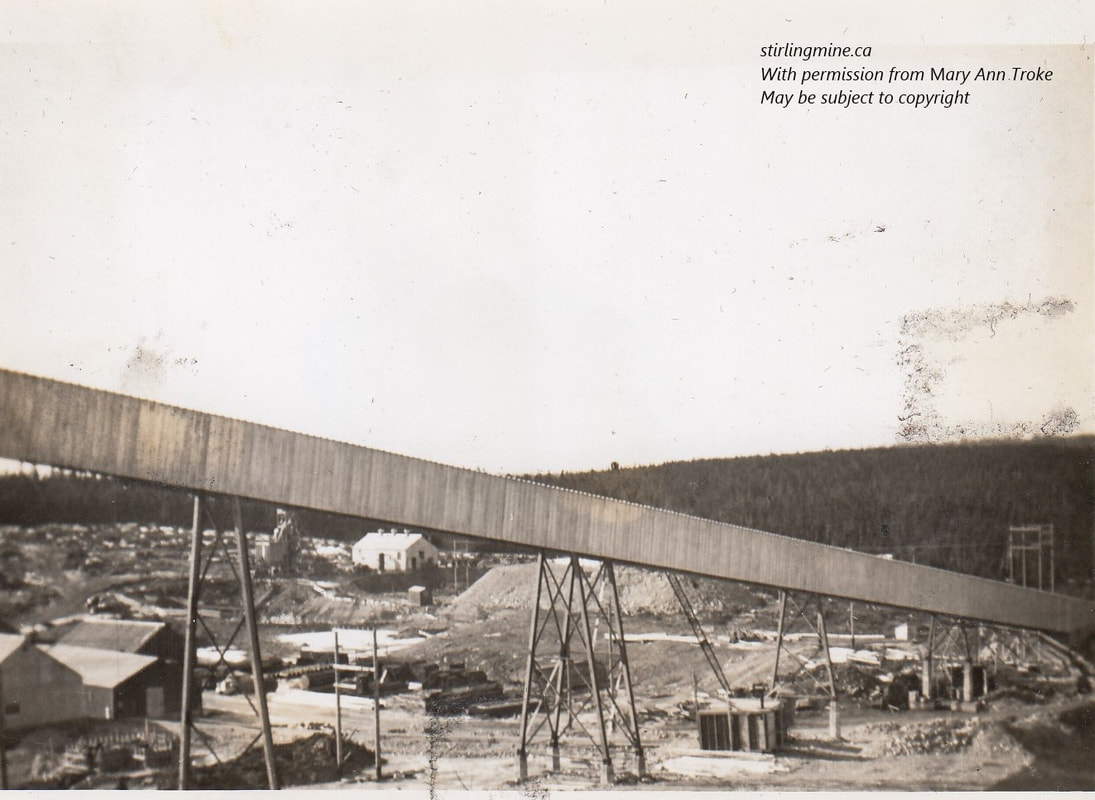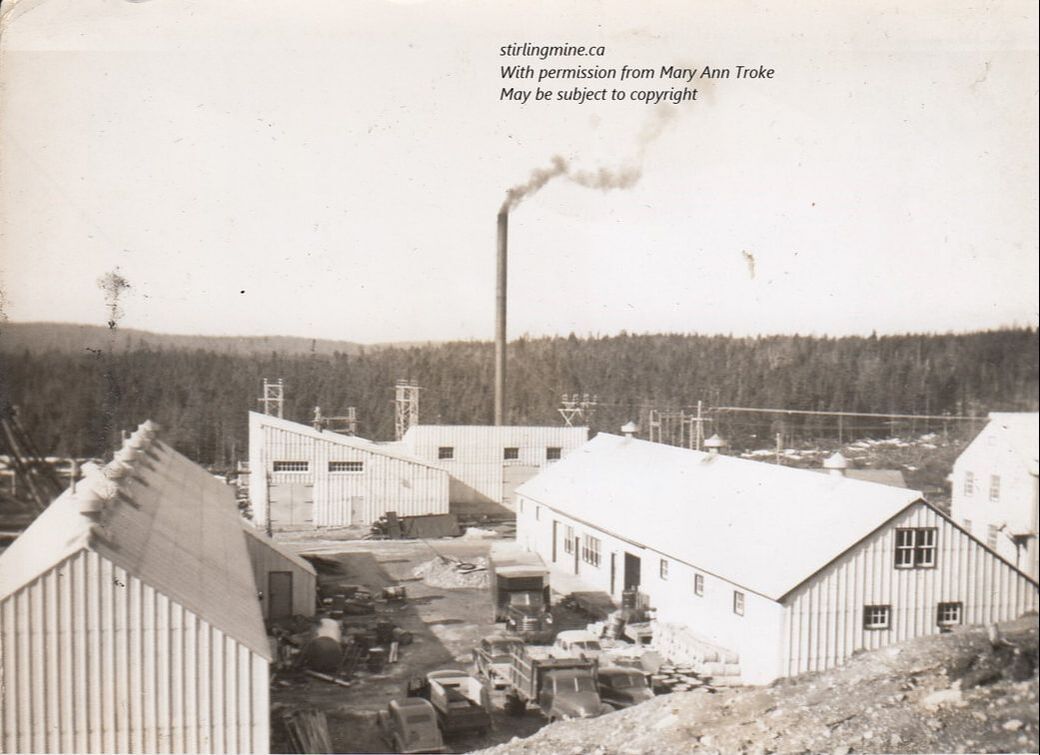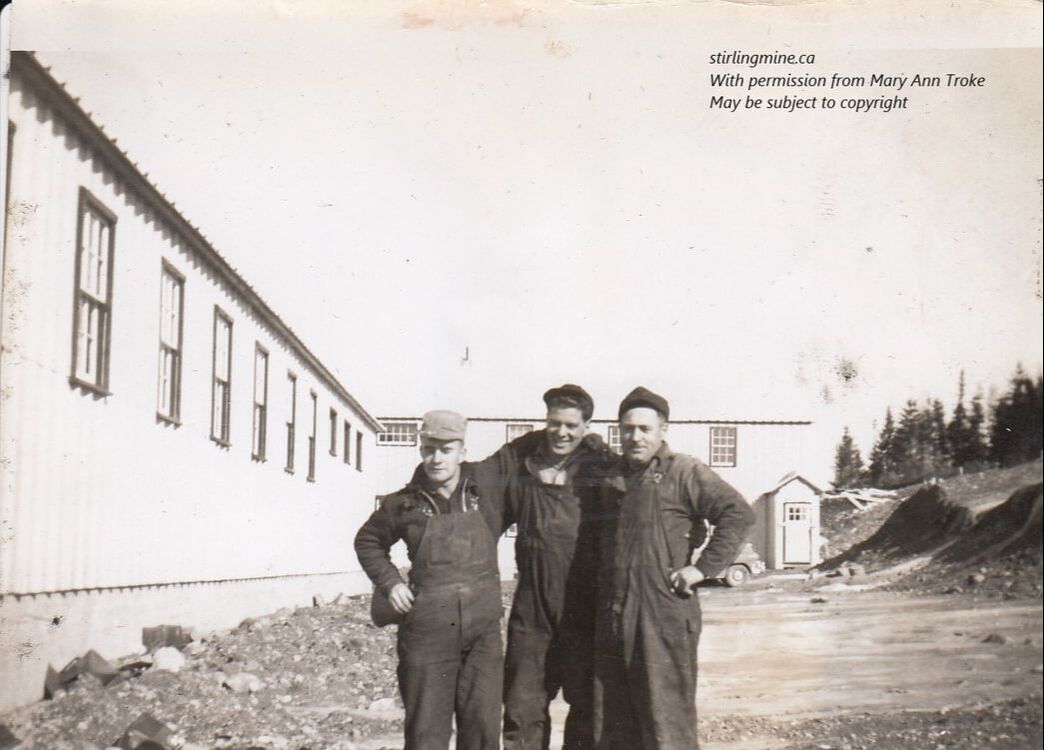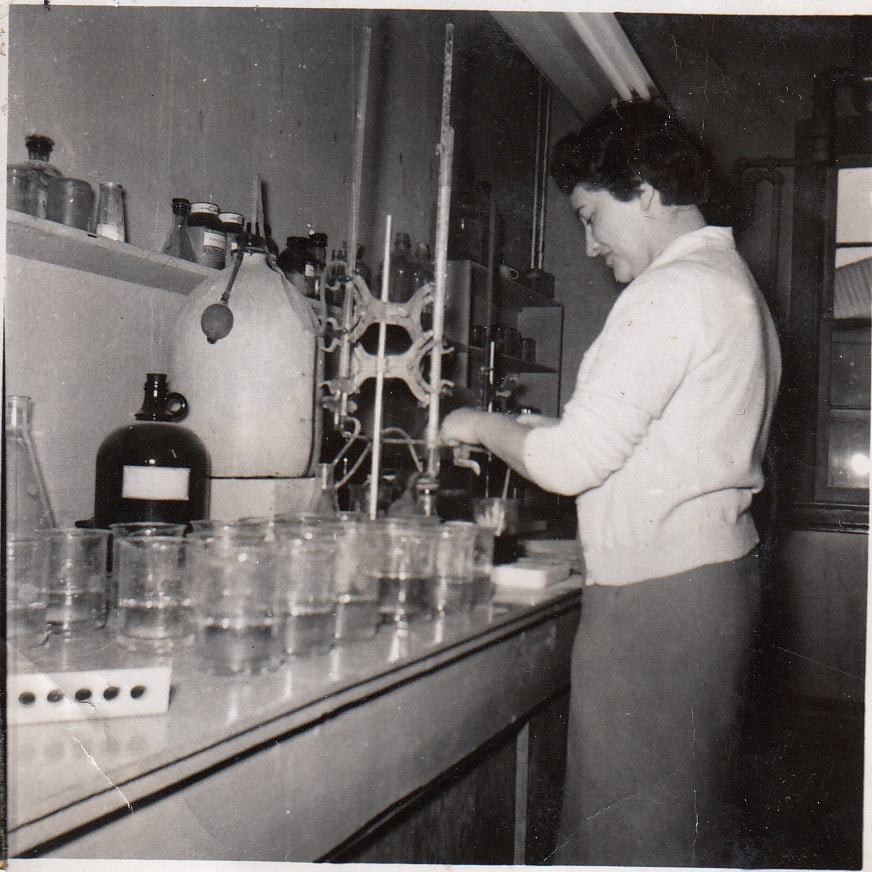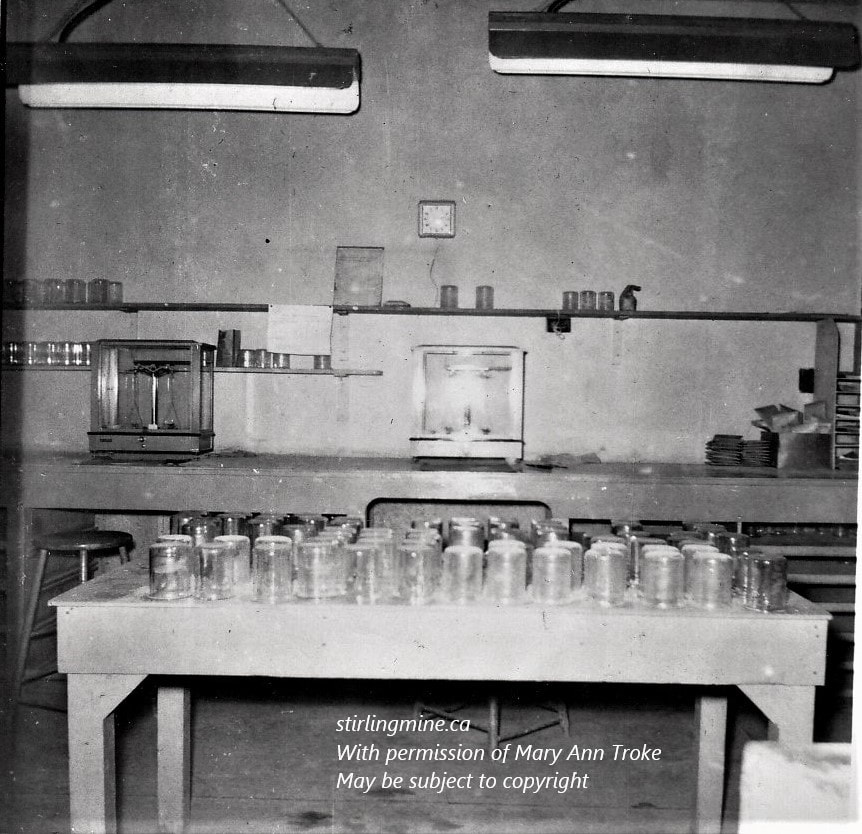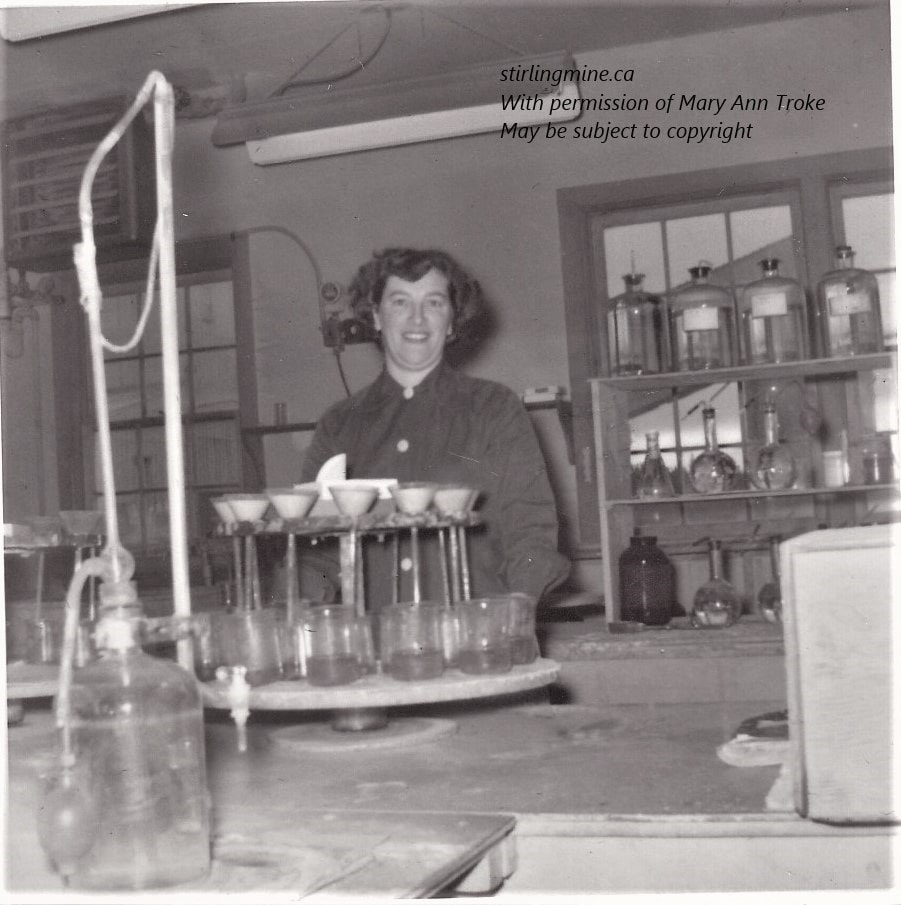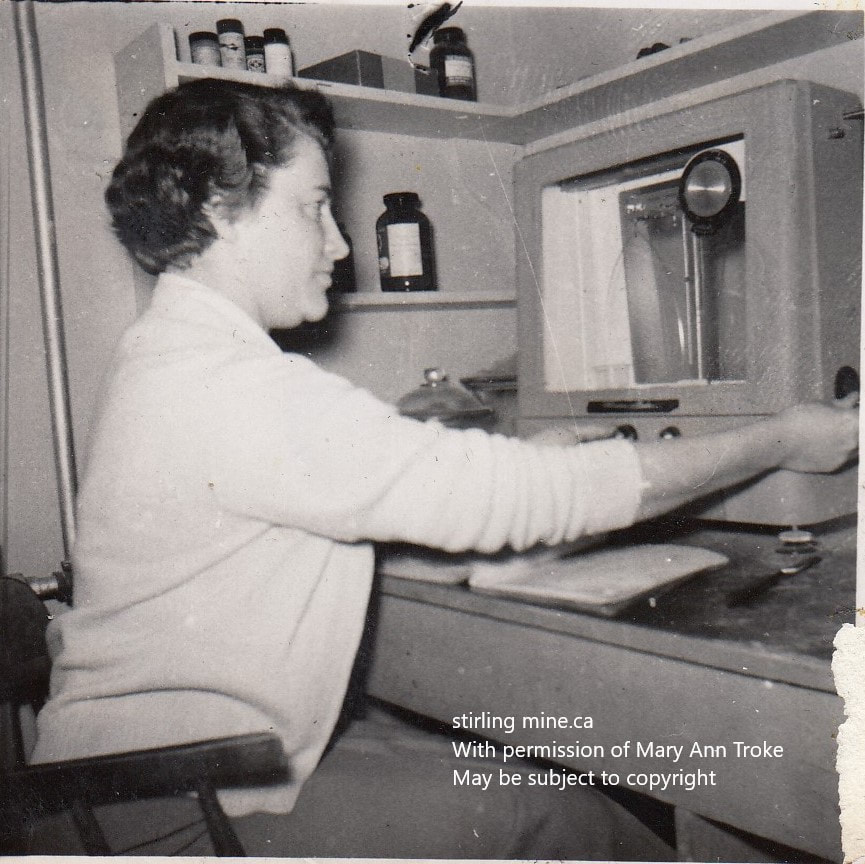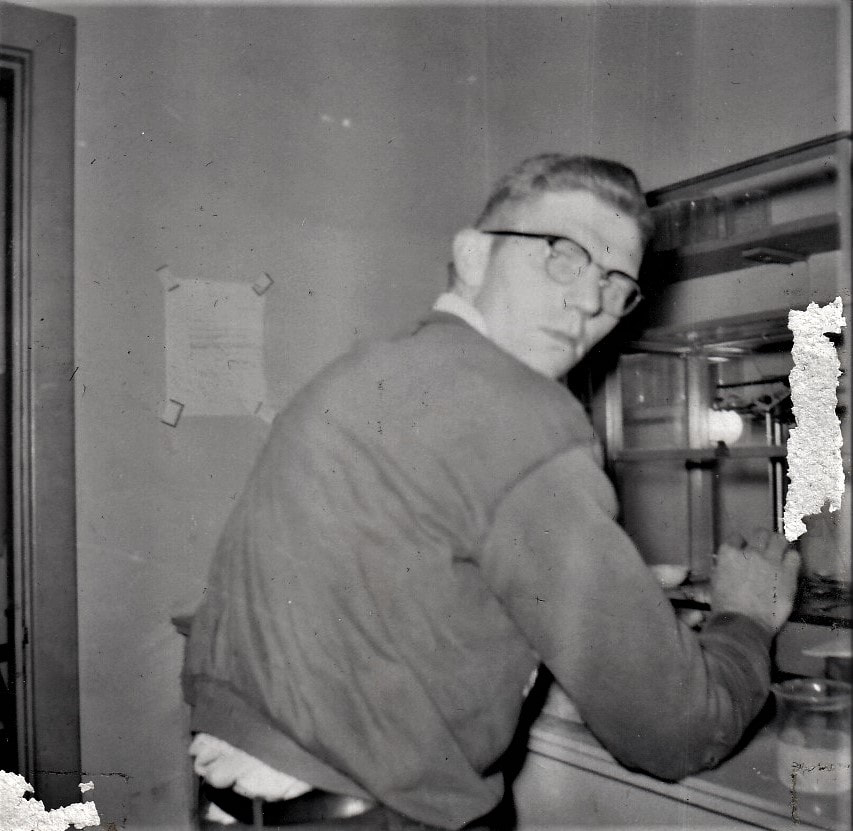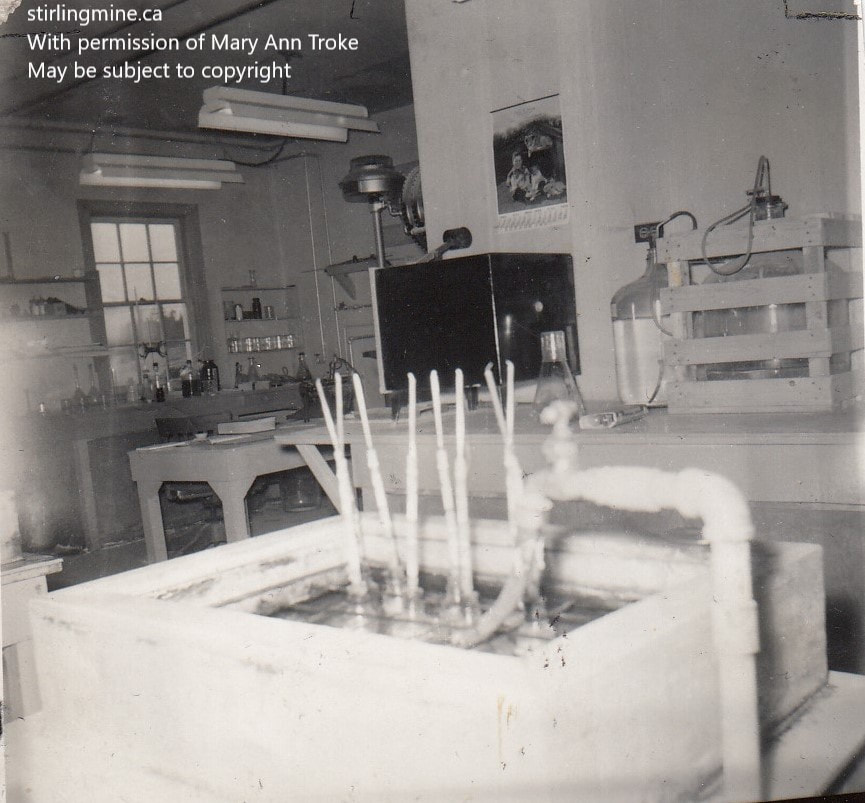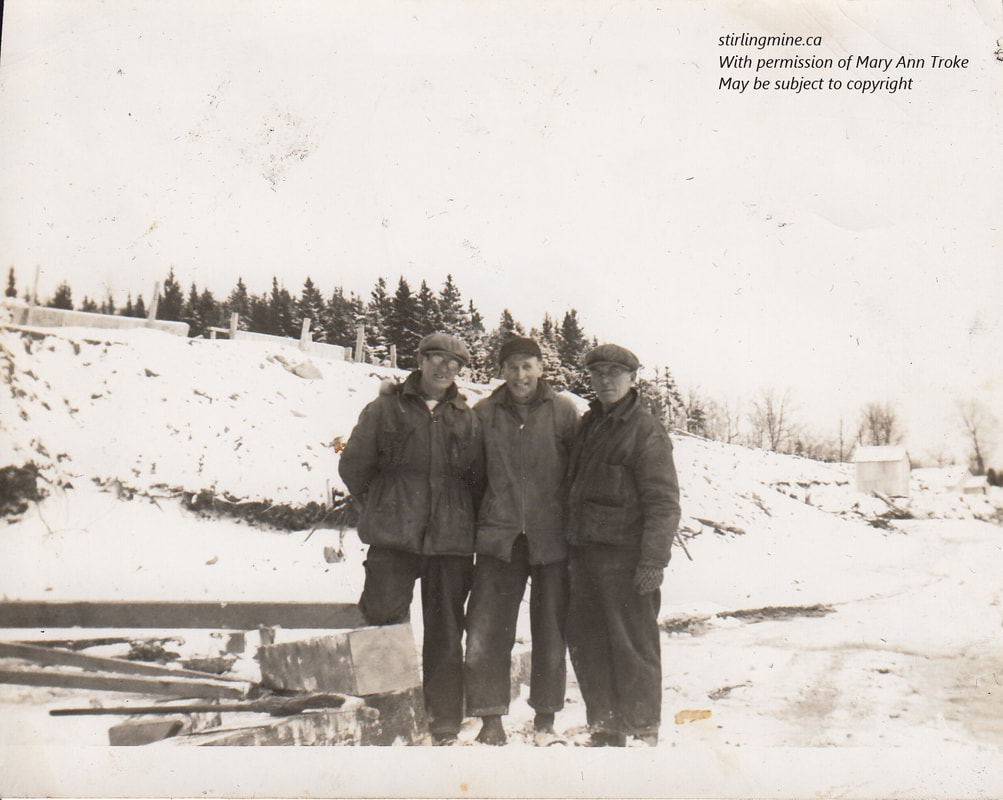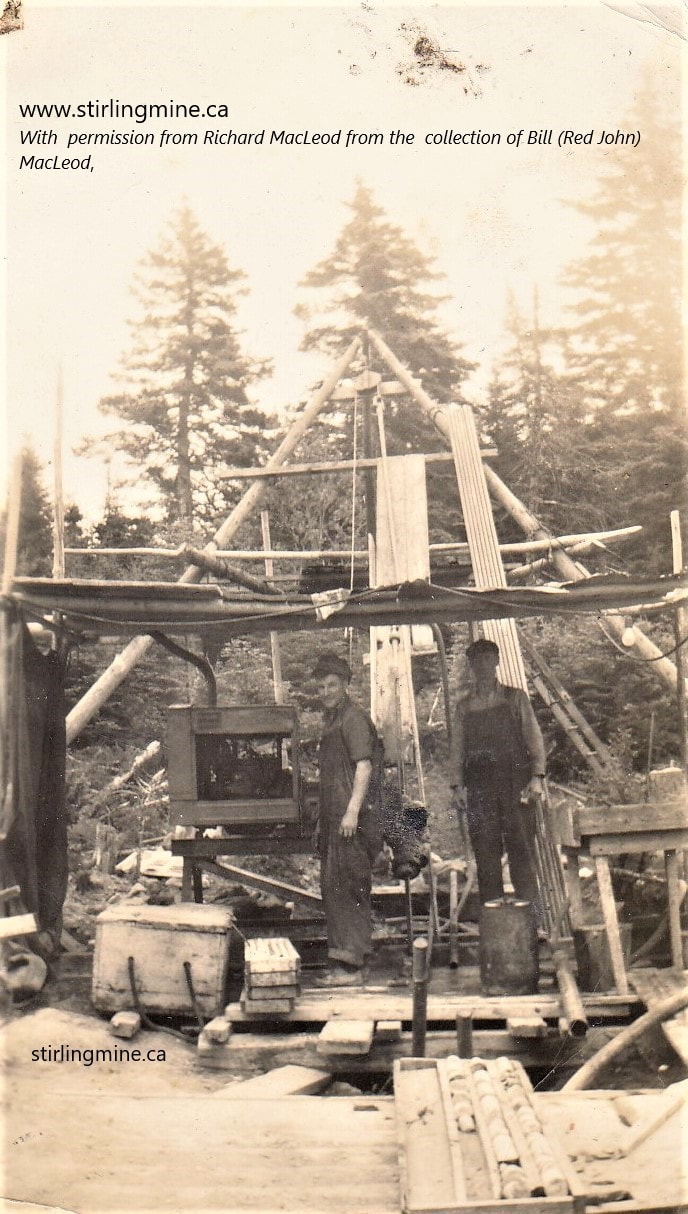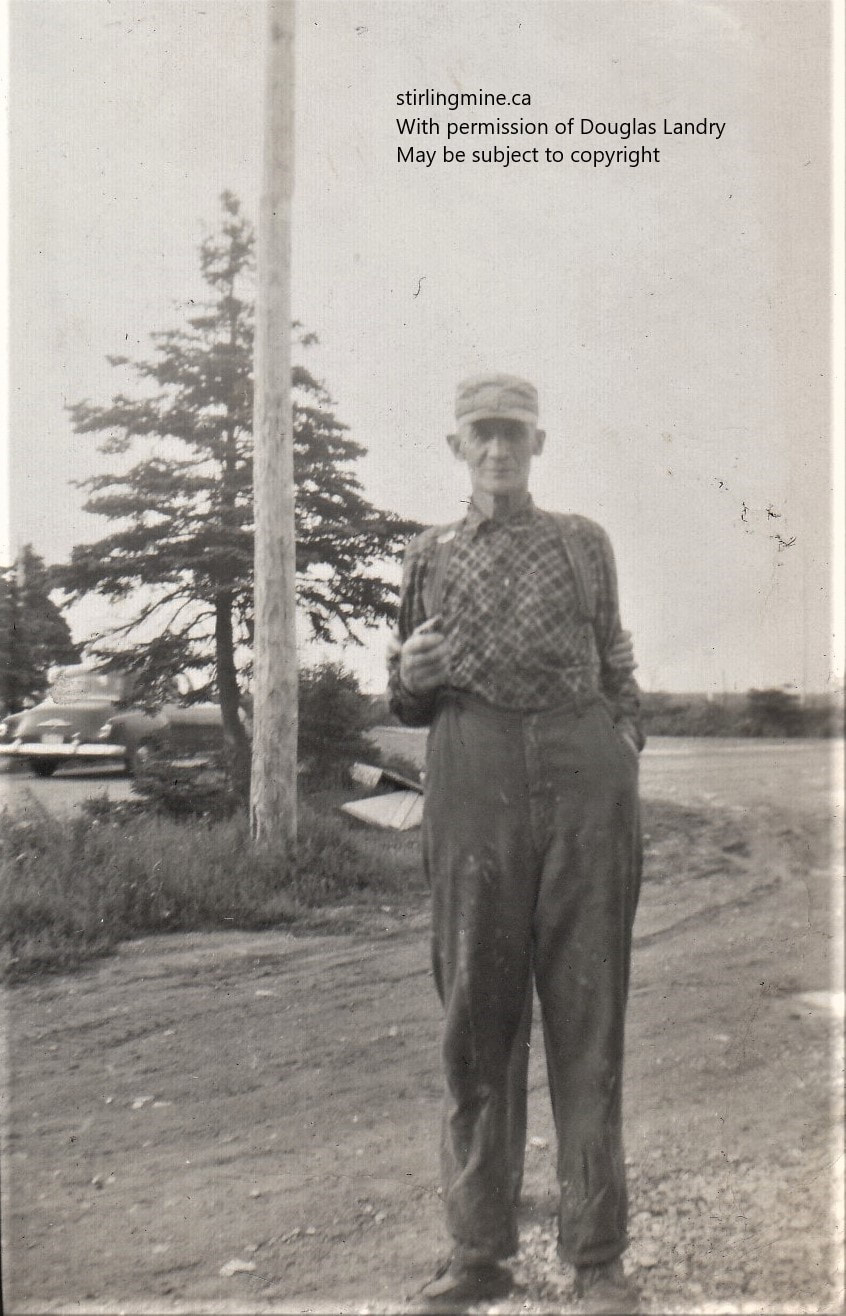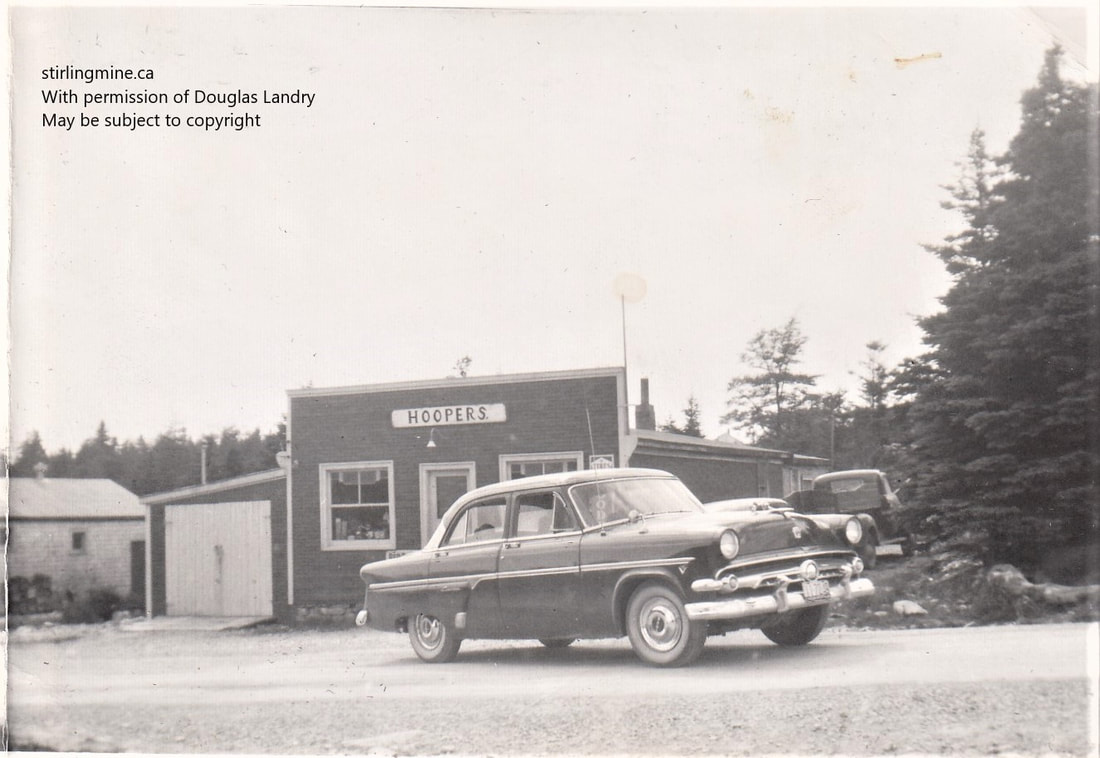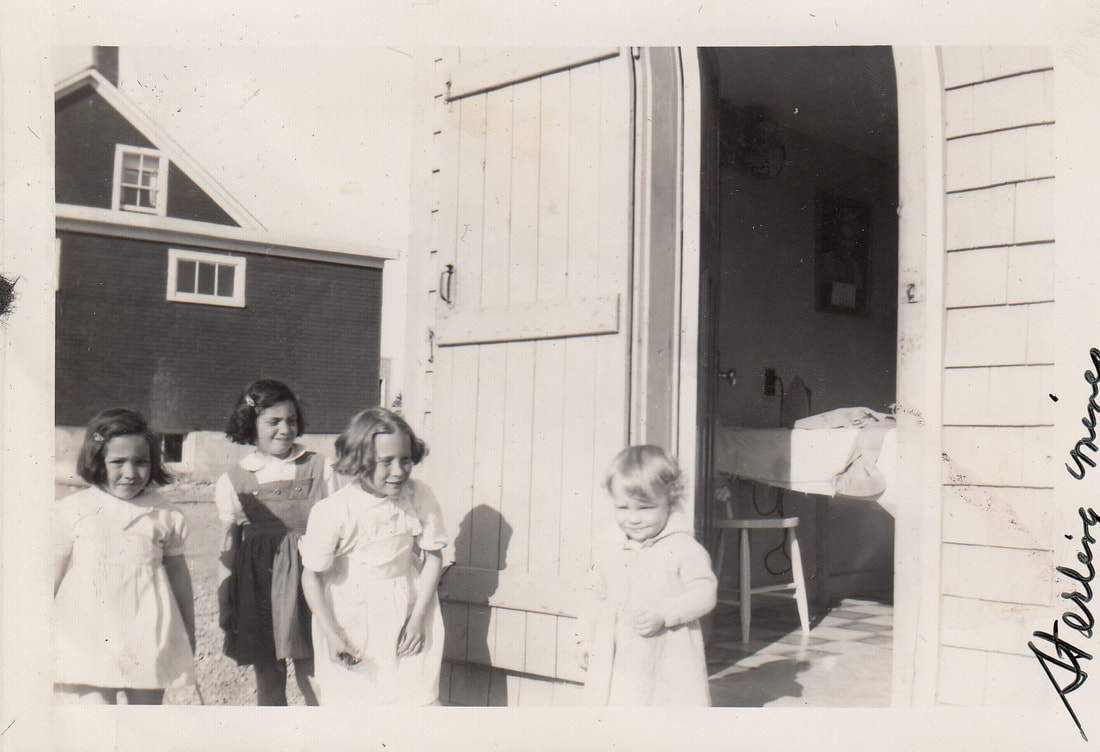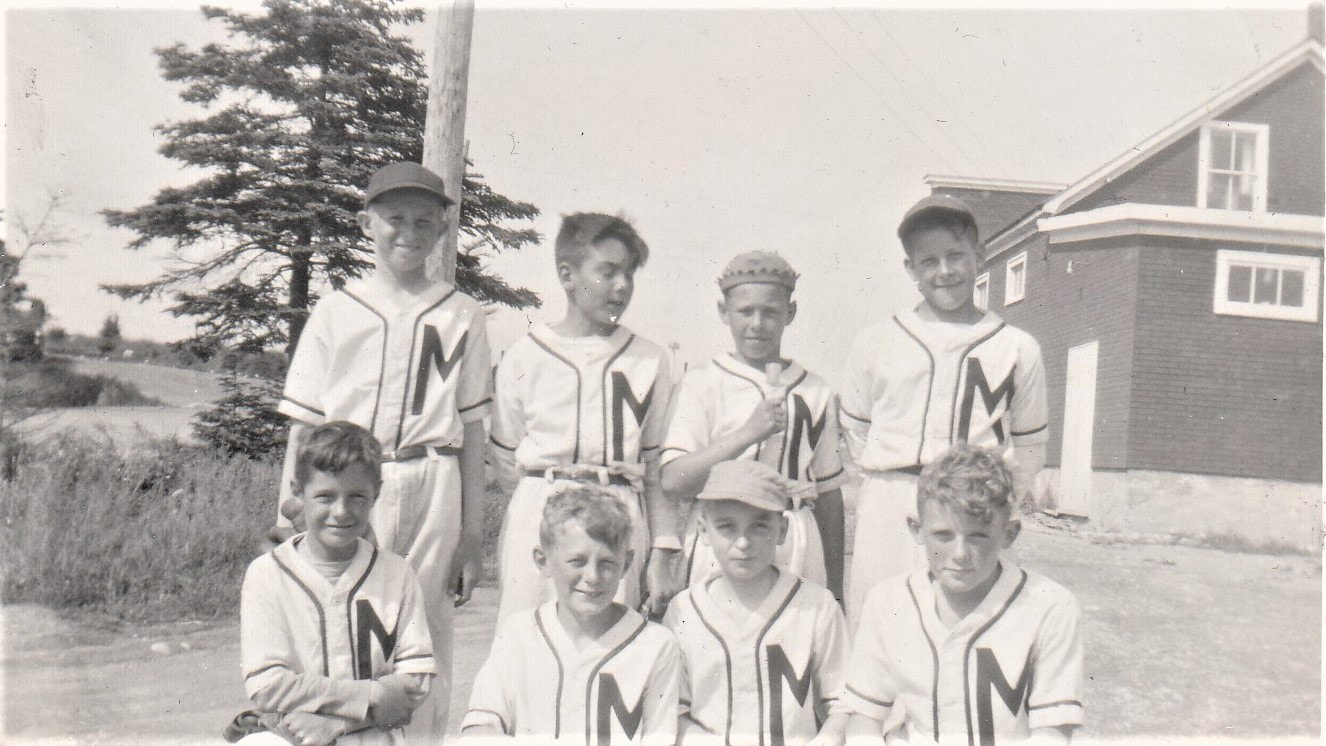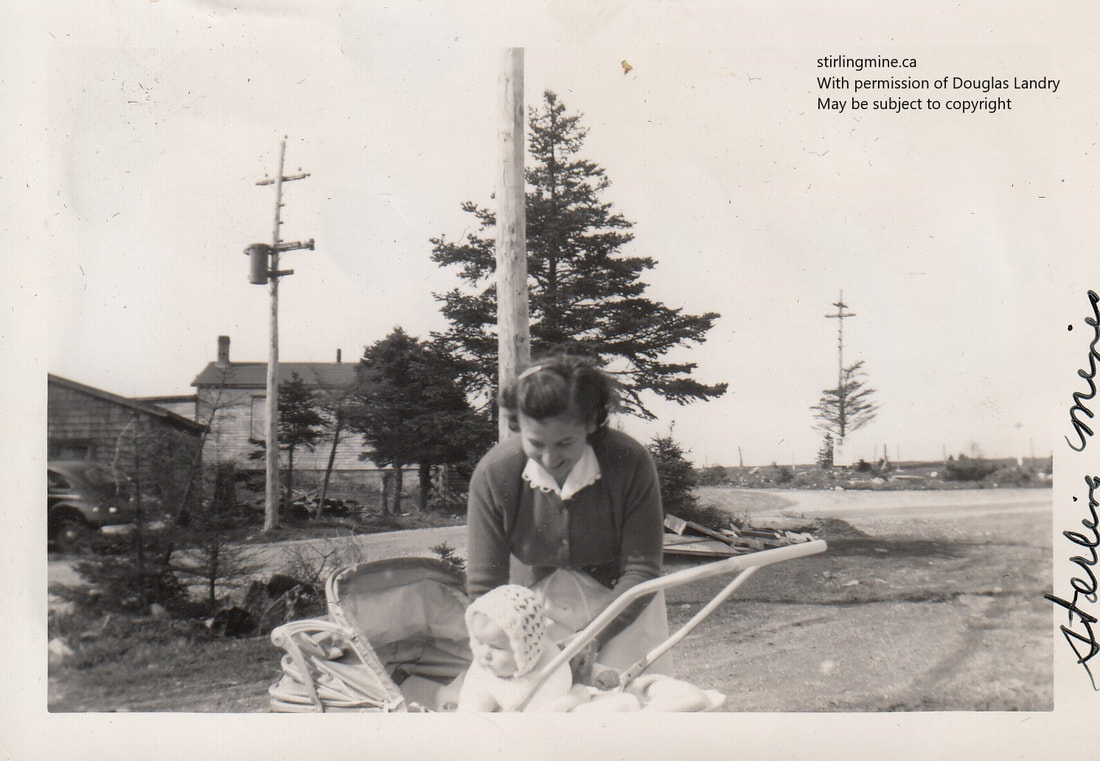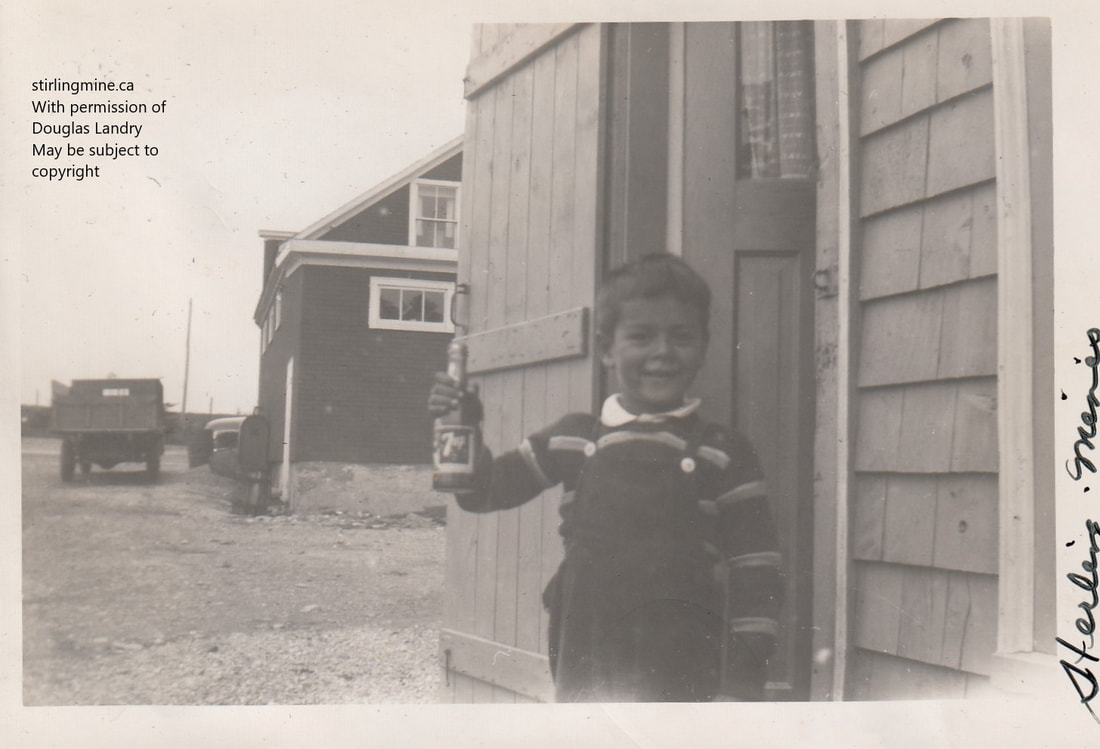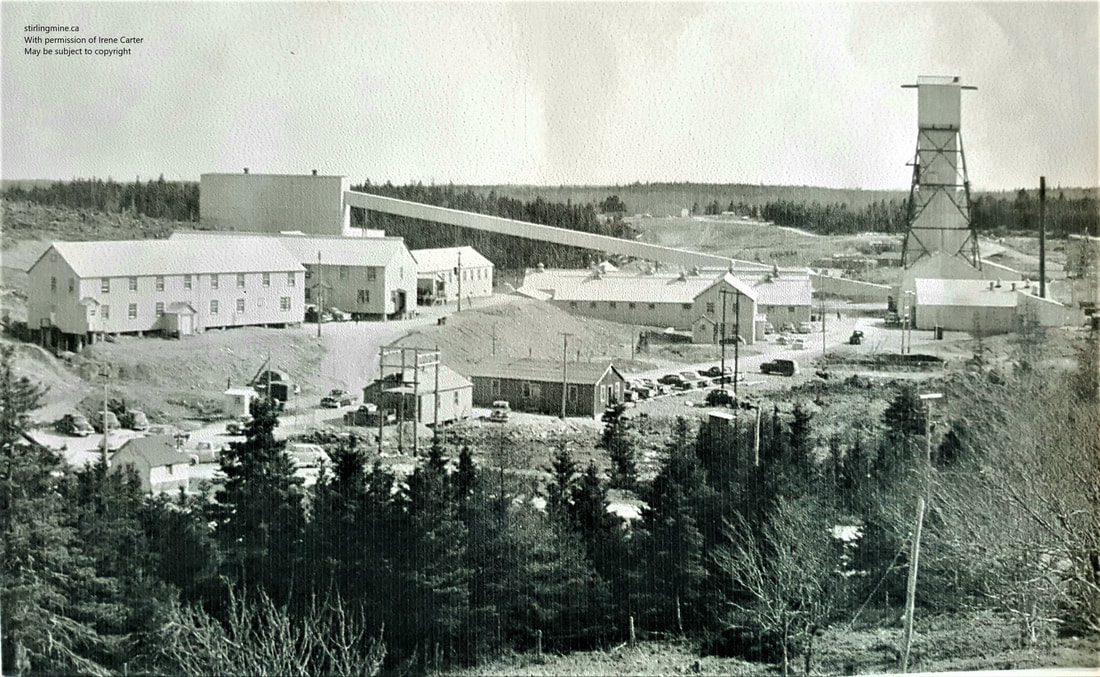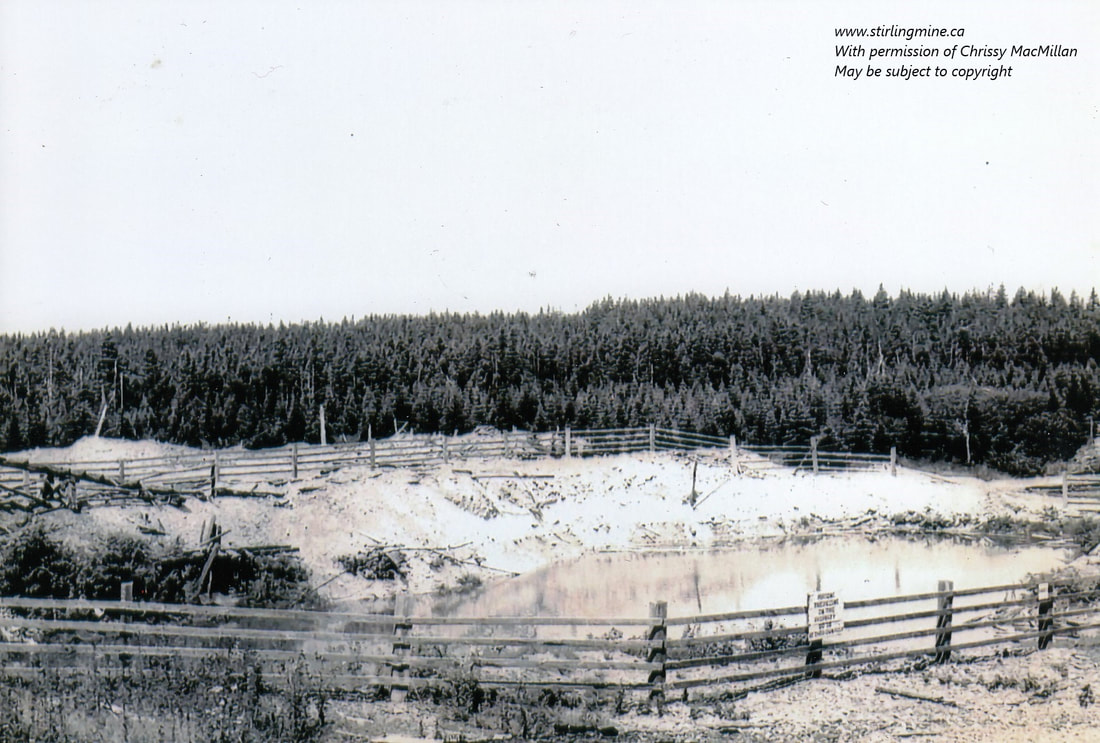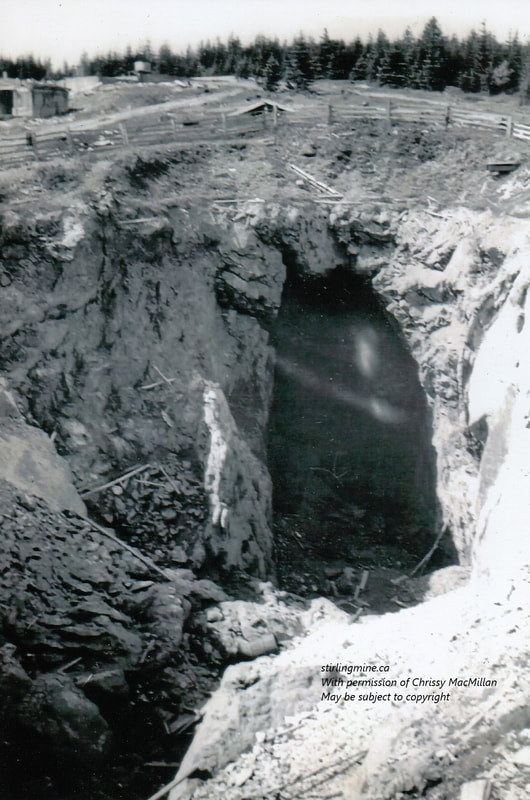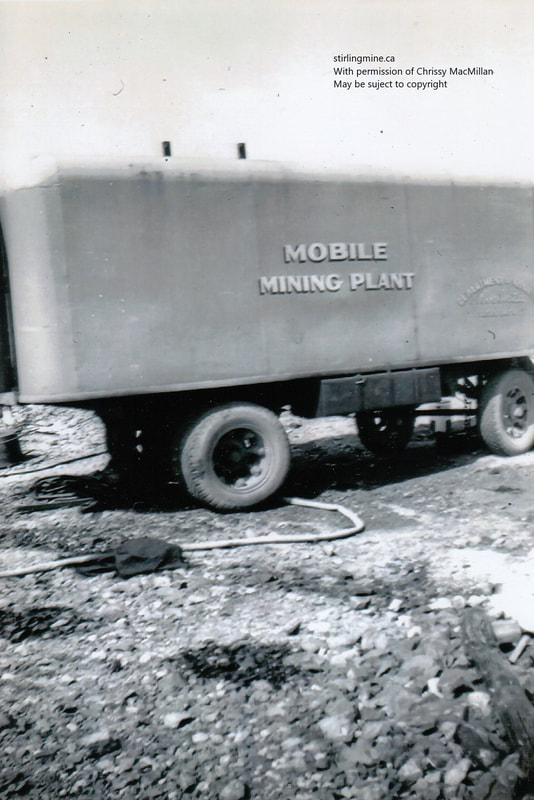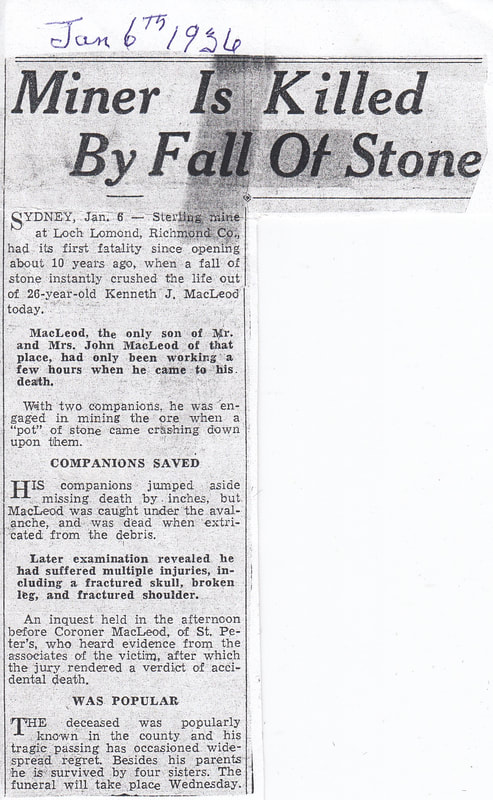Interview with Duncan (Murdock Dan) MacLeod and Chrissie (MacLeod) MacMillan formerly from Stirling
Also, present: Donald Morrison, Greta MacLeod (Duncan’s wife), Jean MacDonald (Chrissie’s daughter), and Sheldon and Shelly MacLeod Duncan and Greta’s son and daughter in law).
The Stirling Bus
Jeanette: How often did the Stirling bus run
Duncan: The bus would leave early in the morning. It would be gone all day, then come back in the evening around 5 O’clock.
Jeanette: OK. Everyday, they ran, when the mine was running?
Duncan: Every second day I think.
Jeanette: Some people said (it ran) once a day, some people said once or twice (a week).
Duncan: See, that bus ran a long time. It ran in the 30’s when the mine ran the fist time.
Jeanette: Mary Gillis said her father would get a ride on that bus coming from Stirling to Sydney. Then he’d get a ride into Glace Bay. He worked in the mine there. That would be in the 30’s I think (40’s).
Duncan: Yeah.
Donald: What was the route? Was it through Grand Mira (North) that it went?
Duncan: No, through Fourchu.
Jeanette: But when they got to Gabarus Lake, they went in that way (through Grand Mira South), right?
Duncan: Yes
Duncan: (Chrissie comes in later and Duncan asks her) Do you know how often the Stirling bus would run?.
Chrissie: On Friday anyway. It was Tues and Friday but I’m not too sure about that.
Jeanette: I think maybe in its hay day, it may have run more often, because it ran even before the mine even opened.
Chrissie: Yes, it did.
Where Duncan worked at the mine
Jeanette: You were saying you worked at the Assay office for a few years. And you did (analyzed) the Zinc and Mary Ann (MacIntosh/Troke) did (analyzed) the copper and the ...
Duncan: The Lead
Jeanette: You were saying you worked at Danny Shaw’s store.
Duncan: Yes
Jeanette: And you worked at my father’s garage (Strachan’s) and you got paid $25/week there and that it was very busy there.
Duncan: Yes
Jeanette: And you said it was open until 9 O’clock at night. It probably opened at 9 (in the morning).
Duncan: No, earlier than that. They’d be there at 7. Your father used to come early and open and then I’d go around 8 O’clock when he would be gone to work at the mine.
Jeanette: Then I guess he’d come back around 4:30. until closing?
Duncan: Yeah
Jeanette: Would you work till 9 O’clock?
Duncan: No
Jeanette: So, he’d take over then.
Duncan: Yes
Jeanette: Do you remember how much you got paid at the mine when you worked there?
Duncan: $1.25 was it?
Duncan and Greta’s house came from the mine
Jeanette: Your house came from the mine, right?
Duncan: Yes
Jeanette: And it was one of the ones from behind John G’s?
Duncan: Yeah. That was MacLeod’s house. He ran the Assay office. And Dolena MacLeod bought it and moved it to North Framboise.
Jeanette: Yes, and when she died, you bought that house, and brought it into Sydney?
Duncan: Yeah.
Jeanette: Do you know what size it is?ah
Duncan: 26’ square. And there was a porch off the house where you went to the basement.
Jeanette: Ok. That explains things, because the last time I was up there (where the foundations of the mine houses are) some of these houses were square and they had…
Duncan: A little jib on the side.
Jeanette: Yes
Duncan: Well that was the porch where you went to the basement.
Donald: Front entrance.
Jeanette: I was trying to figure out what that form was – that cement wall. So, they would walk down there to the basement.
Duncan: Yes. Come to my place and I’ll show you.
Jeanette: So that was one of the bigger houses.
Duncan: Yes. The biggest house was Chisholm’s, the Mine Manager. That was moved to East Bay.
Jeanette: Down by the Meadow’s Road.
Duncan: Yes, the Meadows.
Jeanette: I was looking for it last week, but they painted it.
Duncan: Not only that, they added a piece to it.
Jeanette: Oh, did they? I wonder if there is a picture around before they did that to it.
Jeanette: And on the left going down the mine road before you got to the gate, there were the other Boss’s houses there.
Duncan: Yeah.
Jeanette: They went up behind the bunkhouses.
Duncan: Yeah
Jeanette: That was Bardswick, Bunclark and Michaelson.
Duncan: Yeah.
Jeanette: I know where all those houses went. One Dan Alex (MacLeod) took over (in between his house and Angus Archie and Maude MacQueen’s) for his Mother which Danny (and Anne) had and (later) which Evelyn had which burnt. And Norman Alex (MacLeod) got one. Note: Norman Alex’s son, Allister told me that the second home was one of the older bunkhouses (that Douglas Landry talked about in his interview. I believe it is the one that is in photo #2 is where all the cars are parked. He took it to Framboise where their other house is now, but it burnt and then he got another building from the mine, I don’t know where in the mine it came from. So that’s the second house and the third house is Angus Alex (and Alice) MacLeod’s house down in Marion bridge (See Angus MacLeod’s interview with details about their house).
Working at the mine
Jeanette: Did you enjoy working at the mine?
Duncan: Yes.
Jeanette: Everybody was smiling, for the most part, in any of the pictures I have seen.
Greta: They were smiling at the money they were making.
Jeanette: Doug Landry was saying that people got paid a little bit more there than they would get anywhere else because they didn’t want a union to start.
Duncan: yeah.
Jeanette: I think those people (Mindemar) were good to their employees. They had a recreation centre there.
Duncan: Yeah.
Jeanette: Do you remember that and there was a guy that kind of directed that. He was a Murrin from Glace Bay. Eddie Murrin, do you remember him?
Note: I found a recent Obit of Ed Murrin, Glace Bay. I think this is the same man. He died Feb/19.
Duncan: No, I don’t. I remember the name, but I don’t remember him.
Jeanette: Do you remember they had a hall up back near MacLean’s.
Duncan: yes, and they had a ball field. It was back of the glory hole. Up on the hill.
Jeanette: would the recreation centre be up near there?
Duncan: It would be handy.
Jeanette: More to the right?
Duncan: More to the right.
Jeanette: Did you go to any dances or anything up there?
Duncan: No, I didn’t.
Greta’s story
Jeanette: Do you remember any stories Greta, about the mine?
Greta: We walked from the mine to Fourchu one night.
Jeanette: Laughter. Well that’s a story.
Greta: I was with Helen and Parker Langley, Helen Burns. She was a Burns for Fourchu. Parker had a brother Brent I think, and she was up there. She said, “come on, we have to get the bus”. The bus was going at 9 O’clock. And when we got over there the bus was gone.
Jeanette: 9 O’clock at night. That bus - the Stirling Bus - it would run that late!
Greta: Yes. Well anyway, she said, “We’ll walk” and Parker said, “Yes, it’s not far”. Well, I was scared to death. I was looking for bears and everything else. I was only young, you know. I was scared to death, honest to god, because it was nothing but woods, you know. Havelock Shephard came along and he was going to the mine, but he couldn’t take us back because he had to get on the thing (the cage) to take him underground. After we got home, I got in bed but who came in the house but Lawrence (Burns) coming off the shift.
Jeanette: Oh, no.
Greta: I said to Helen, “didn’t you know he worked 4-12”. Laughter.
Note: Fourchu is at least 12 miles from Stirling mine. Sounds like they took 3 hours to get home.
Water and heating
Jeanette: All the heating system for the mine came from the boiler house. There was a big boiler room there. George MacGillivary ran that.
Duncan: Yeah.
Jeanette: Everything was heated by steam and when they were dismantling they made sure they took all those metal pipes. Douglas (Landry) said the water came in – they didn’t have metal pipes they used wooden troughs for the water. Do you remember ever seeing anything like that coming from the pumphouse in Stirling?
Duncan: I don’t know what you call them, but they were wooden all right.
Jeanette: It probably wasn’t even closed in.
Duncan: No. It was closed in. It was like a Bamboo tree, you know.
Donald: It was hollow.
Jeanette: Oh, so, it was hollow like a pipe. (Editor note: Harvey Freeman, Architect, notes that this was "Wood Stave Piping" and has provided a link for further information on this system. To check it out, click here on Links. Harvey also notes that " if someone saw the finished pipe made up from a number of pieces of wood they may think it looked like a big piece of bamboo. Bamboo was used for water pipes. Solid wood logs were also bored out as water pipes in North America with the ends shaped to fit one inside the other."
Jeanette: Do you remember where the water tower was?
Duncan: Yes. I remember where the pumphouse was. It was right at the mouth of the river (on the Five Island Lake aka Stirling Lake) going to Angus Morrison’s.
Jeanette: Do you remember that there was a dam there.
Duncan: Yeah.
Jeanette: and that would stop the water from going down the brook and down to Barker’s corner. They’d build up the water, so they’d have lots of water in the lake.
Duncan: Yes
Jeanette: I remember the pumphouse foundation because that’s where wee used to swim at the Stirling lake. So, they’d pump water out of there into those wooden things.
Headframe/hoist
Jeanette: (The Headframe) What was that for?
Duncan: That was for the hoist.
Jeanette: To hoist the ore or the people?
Duncan: The ore and the people.
Jeanette: Did they have two shafts for that - one for the people and one for the ore?
Duncan: Oh, Yes.
Note: Alex Angus MacLeod notes there were two skips, one was usually used for the miner’s/supplies and the other for the ore.
Also, present: Donald Morrison, Greta MacLeod (Duncan’s wife), Jean MacDonald (Chrissie’s daughter), and Sheldon and Shelly MacLeod Duncan and Greta’s son and daughter in law).
The Stirling Bus
Jeanette: How often did the Stirling bus run
Duncan: The bus would leave early in the morning. It would be gone all day, then come back in the evening around 5 O’clock.
Jeanette: OK. Everyday, they ran, when the mine was running?
Duncan: Every second day I think.
Jeanette: Some people said (it ran) once a day, some people said once or twice (a week).
Duncan: See, that bus ran a long time. It ran in the 30’s when the mine ran the fist time.
Jeanette: Mary Gillis said her father would get a ride on that bus coming from Stirling to Sydney. Then he’d get a ride into Glace Bay. He worked in the mine there. That would be in the 30’s I think (40’s).
Duncan: Yeah.
Donald: What was the route? Was it through Grand Mira (North) that it went?
Duncan: No, through Fourchu.
Jeanette: But when they got to Gabarus Lake, they went in that way (through Grand Mira South), right?
Duncan: Yes
Duncan: (Chrissie comes in later and Duncan asks her) Do you know how often the Stirling bus would run?.
Chrissie: On Friday anyway. It was Tues and Friday but I’m not too sure about that.
Jeanette: I think maybe in its hay day, it may have run more often, because it ran even before the mine even opened.
Chrissie: Yes, it did.
Where Duncan worked at the mine
Jeanette: You were saying you worked at the Assay office for a few years. And you did (analyzed) the Zinc and Mary Ann (MacIntosh/Troke) did (analyzed) the copper and the ...
Duncan: The Lead
Jeanette: You were saying you worked at Danny Shaw’s store.
Duncan: Yes
Jeanette: And you worked at my father’s garage (Strachan’s) and you got paid $25/week there and that it was very busy there.
Duncan: Yes
Jeanette: And you said it was open until 9 O’clock at night. It probably opened at 9 (in the morning).
Duncan: No, earlier than that. They’d be there at 7. Your father used to come early and open and then I’d go around 8 O’clock when he would be gone to work at the mine.
Jeanette: Then I guess he’d come back around 4:30. until closing?
Duncan: Yeah
Jeanette: Would you work till 9 O’clock?
Duncan: No
Jeanette: So, he’d take over then.
Duncan: Yes
Jeanette: Do you remember how much you got paid at the mine when you worked there?
Duncan: $1.25 was it?
Duncan and Greta’s house came from the mine
Jeanette: Your house came from the mine, right?
Duncan: Yes
Jeanette: And it was one of the ones from behind John G’s?
Duncan: Yeah. That was MacLeod’s house. He ran the Assay office. And Dolena MacLeod bought it and moved it to North Framboise.
Jeanette: Yes, and when she died, you bought that house, and brought it into Sydney?
Duncan: Yeah.
Jeanette: Do you know what size it is?ah
Duncan: 26’ square. And there was a porch off the house where you went to the basement.
Jeanette: Ok. That explains things, because the last time I was up there (where the foundations of the mine houses are) some of these houses were square and they had…
Duncan: A little jib on the side.
Jeanette: Yes
Duncan: Well that was the porch where you went to the basement.
Donald: Front entrance.
Jeanette: I was trying to figure out what that form was – that cement wall. So, they would walk down there to the basement.
Duncan: Yes. Come to my place and I’ll show you.
Jeanette: So that was one of the bigger houses.
Duncan: Yes. The biggest house was Chisholm’s, the Mine Manager. That was moved to East Bay.
Jeanette: Down by the Meadow’s Road.
Duncan: Yes, the Meadows.
Jeanette: I was looking for it last week, but they painted it.
Duncan: Not only that, they added a piece to it.
Jeanette: Oh, did they? I wonder if there is a picture around before they did that to it.
Jeanette: And on the left going down the mine road before you got to the gate, there were the other Boss’s houses there.
Duncan: Yeah.
Jeanette: They went up behind the bunkhouses.
Duncan: Yeah
Jeanette: That was Bardswick, Bunclark and Michaelson.
Duncan: Yeah.
Jeanette: I know where all those houses went. One Dan Alex (MacLeod) took over (in between his house and Angus Archie and Maude MacQueen’s) for his Mother which Danny (and Anne) had and (later) which Evelyn had which burnt. And Norman Alex (MacLeod) got one. Note: Norman Alex’s son, Allister told me that the second home was one of the older bunkhouses (that Douglas Landry talked about in his interview. I believe it is the one that is in photo #2 is where all the cars are parked. He took it to Framboise where their other house is now, but it burnt and then he got another building from the mine, I don’t know where in the mine it came from. So that’s the second house and the third house is Angus Alex (and Alice) MacLeod’s house down in Marion bridge (See Angus MacLeod’s interview with details about their house).
Working at the mine
Jeanette: Did you enjoy working at the mine?
Duncan: Yes.
Jeanette: Everybody was smiling, for the most part, in any of the pictures I have seen.
Greta: They were smiling at the money they were making.
Jeanette: Doug Landry was saying that people got paid a little bit more there than they would get anywhere else because they didn’t want a union to start.
Duncan: yeah.
Jeanette: I think those people (Mindemar) were good to their employees. They had a recreation centre there.
Duncan: Yeah.
Jeanette: Do you remember that and there was a guy that kind of directed that. He was a Murrin from Glace Bay. Eddie Murrin, do you remember him?
Note: I found a recent Obit of Ed Murrin, Glace Bay. I think this is the same man. He died Feb/19.
Duncan: No, I don’t. I remember the name, but I don’t remember him.
Jeanette: Do you remember they had a hall up back near MacLean’s.
Duncan: yes, and they had a ball field. It was back of the glory hole. Up on the hill.
Jeanette: would the recreation centre be up near there?
Duncan: It would be handy.
Jeanette: More to the right?
Duncan: More to the right.
Jeanette: Did you go to any dances or anything up there?
Duncan: No, I didn’t.
Greta’s story
Jeanette: Do you remember any stories Greta, about the mine?
Greta: We walked from the mine to Fourchu one night.
Jeanette: Laughter. Well that’s a story.
Greta: I was with Helen and Parker Langley, Helen Burns. She was a Burns for Fourchu. Parker had a brother Brent I think, and she was up there. She said, “come on, we have to get the bus”. The bus was going at 9 O’clock. And when we got over there the bus was gone.
Jeanette: 9 O’clock at night. That bus - the Stirling Bus - it would run that late!
Greta: Yes. Well anyway, she said, “We’ll walk” and Parker said, “Yes, it’s not far”. Well, I was scared to death. I was looking for bears and everything else. I was only young, you know. I was scared to death, honest to god, because it was nothing but woods, you know. Havelock Shephard came along and he was going to the mine, but he couldn’t take us back because he had to get on the thing (the cage) to take him underground. After we got home, I got in bed but who came in the house but Lawrence (Burns) coming off the shift.
Jeanette: Oh, no.
Greta: I said to Helen, “didn’t you know he worked 4-12”. Laughter.
Note: Fourchu is at least 12 miles from Stirling mine. Sounds like they took 3 hours to get home.
Water and heating
Jeanette: All the heating system for the mine came from the boiler house. There was a big boiler room there. George MacGillivary ran that.
Duncan: Yeah.
Jeanette: Everything was heated by steam and when they were dismantling they made sure they took all those metal pipes. Douglas (Landry) said the water came in – they didn’t have metal pipes they used wooden troughs for the water. Do you remember ever seeing anything like that coming from the pumphouse in Stirling?
Duncan: I don’t know what you call them, but they were wooden all right.
Jeanette: It probably wasn’t even closed in.
Duncan: No. It was closed in. It was like a Bamboo tree, you know.
Donald: It was hollow.
Jeanette: Oh, so, it was hollow like a pipe. (Editor note: Harvey Freeman, Architect, notes that this was "Wood Stave Piping" and has provided a link for further information on this system. To check it out, click here on Links. Harvey also notes that " if someone saw the finished pipe made up from a number of pieces of wood they may think it looked like a big piece of bamboo. Bamboo was used for water pipes. Solid wood logs were also bored out as water pipes in North America with the ends shaped to fit one inside the other."
Jeanette: Do you remember where the water tower was?
Duncan: Yes. I remember where the pumphouse was. It was right at the mouth of the river (on the Five Island Lake aka Stirling Lake) going to Angus Morrison’s.
Jeanette: Do you remember that there was a dam there.
Duncan: Yeah.
Jeanette: and that would stop the water from going down the brook and down to Barker’s corner. They’d build up the water, so they’d have lots of water in the lake.
Duncan: Yes
Jeanette: I remember the pumphouse foundation because that’s where wee used to swim at the Stirling lake. So, they’d pump water out of there into those wooden things.
Headframe/hoist
Jeanette: (The Headframe) What was that for?
Duncan: That was for the hoist.
Jeanette: To hoist the ore or the people?
Duncan: The ore and the people.
Jeanette: Did they have two shafts for that - one for the people and one for the ore?
Duncan: Oh, Yes.
Note: Alex Angus MacLeod notes there were two skips, one was usually used for the miner’s/supplies and the other for the ore.
Showing a picture of the mine when it ran in the 30's (above).
Donald: Now, would this have been here in the 50’s?
Duncan: No.
Jeanette: Everything was taken down right?
Duncan: Yes.
Jeanette: Bessie told me they tore everything down when they closed in the 30’s.
Duncan: Yes
Donald: Is that right?
Jeanette: (They) tore it down or moved it out.
Duncan: Yes. There was nothing left.
Jeanette: There were three beautiful big houses on the hill, and more nice houses farther over on the other side of the pond there in the 30’s. I’m not sure what ever happened to them.
Donald: Now, would this have been here in the 50’s?
Duncan: No.
Jeanette: Everything was taken down right?
Duncan: Yes.
Jeanette: Bessie told me they tore everything down when they closed in the 30’s.
Duncan: Yes
Donald: Is that right?
Jeanette: (They) tore it down or moved it out.
Duncan: Yes. There was nothing left.
Jeanette: There were three beautiful big houses on the hill, and more nice houses farther over on the other side of the pond there in the 30’s. I’m not sure what ever happened to them.
Where Duncan Worked
Jeanette: Is that Leonard Burke (see picture above)
Duncan: Yes
Jeanette: Is that Leonard Burke (see picture above)
Duncan: Yes
Jeanette: This is your boss (Mac MacLeod), right (see picture above).
Duncan: Yes
Duncan: Yes
Jeanette: This is Malcolm Dan MacIntosh, right (see picture below)?
Duncan: Yes
Jeanette: But Mary Ann didn’t’ think he worked there. Was he just there for a picture or …?
Duncan: He’d be there for a picture.
Jeanette: He was a carpenter, right?
Duncan: Yes
Jeanette: So, he was likely visiting there, that’s his wife there (Mary Ann).
Duncan: Yes. They just took a picture.
Jeanette: And that’s what we all kind of thought.
Duncan: Yes
Jeanette: But Mary Ann didn’t’ think he worked there. Was he just there for a picture or …?
Duncan: He’d be there for a picture.
Jeanette: He was a carpenter, right?
Duncan: Yes
Jeanette: So, he was likely visiting there, that’s his wife there (Mary Ann).
Duncan: Yes. They just took a picture.
Jeanette: And that’s what we all kind of thought.
Jeanette: And this is you here (picture above).
Duncan: Yes
Shelly: Oh, look how young you were?
Donald: What happened to the hair up here.
Donald: And is that Mary Anne over there?
Duncan: Yes, that’s Mary Ann (in the background).
Jeanette: These are Mary Ann’s pictures.
Jeanette: and is that Leonard Burke beside you (on the right). He seems to have the same shirt on as the person in the other picture.
Duncan: Yes
Duncan: Yes
Shelly: Oh, look how young you were?
Donald: What happened to the hair up here.
Donald: And is that Mary Anne over there?
Duncan: Yes, that’s Mary Ann (in the background).
Jeanette: These are Mary Ann’s pictures.
Jeanette: and is that Leonard Burke beside you (on the right). He seems to have the same shirt on as the person in the other picture.
Duncan: Yes
Jeanette: And there’s Duncan again (picture above).
Donald: How old would you be there, Duncan?
Duncan: In 55, I’d be 18.
Jeanette: That was pretty good, you got a job in a good office like that at 18 years of age.
Duncan: That’s how I got the job at the plant.
Jeanette: Because of the work you did there? Was that what you did at the plant, something similar to that?
Greta: Yes, he did.
Donald: Sheldon, just think if that mine would have kept going you would have been going to school up here. Your life would have been totally different.
Shelly (Sheldon’s wife): We would never have met!
Donald: How old would you be there, Duncan?
Duncan: In 55, I’d be 18.
Jeanette: That was pretty good, you got a job in a good office like that at 18 years of age.
Duncan: That’s how I got the job at the plant.
Jeanette: Because of the work you did there? Was that what you did at the plant, something similar to that?
Greta: Yes, he did.
Donald: Sheldon, just think if that mine would have kept going you would have been going to school up here. Your life would have been totally different.
Shelly (Sheldon’s wife): We would never have met!
Jeanette: Is that Jim MacNeil (picture above).
Duncan: Yeah, Jim MacNeil.
Jeanette: Did you notice what he has on?
Duncan:" Mindemar".
Jeanette: "Mindemar, Stirling",
Jeanette: He and his brother worked in that office. They were young fellows too.
Duncan: He was a year older than I was.
Donald: Was he the guy who sang Gaelic?
Jeanette: Yes. He was the Gaelic guy.
Chrissie: That’s the MacNeil boy. That’s who that is. He was an awfully nice boy.
Jeanette: Martin worked there too, right.
Chrissie: Martin worked there too.
Jeanette: He was younger than Jim, right?
Chrissie: He was younger than Jim.
Duncan: Yeah, Jim MacNeil.
Jeanette: Did you notice what he has on?
Duncan:" Mindemar".
Jeanette: "Mindemar, Stirling",
Jeanette: He and his brother worked in that office. They were young fellows too.
Duncan: He was a year older than I was.
Donald: Was he the guy who sang Gaelic?
Jeanette: Yes. He was the Gaelic guy.
Chrissie: That’s the MacNeil boy. That’s who that is. He was an awfully nice boy.
Jeanette: Martin worked there too, right.
Chrissie: Martin worked there too.
Jeanette: He was younger than Jim, right?
Chrissie: He was younger than Jim.
Jeanette: There’s Mary Ann MacIntosh (above).
Duncan: See, she was doing the copper and lead.
Jeanette: And so those were beakers. She was putting the ore in them, was she?
Duncan: She was putting a sample in there.
Jeanette: To analyze it?
Duncan: See, she was doing the copper and lead.
Jeanette: And so those were beakers. She was putting the ore in them, was she?
Duncan: She was putting a sample in there.
Jeanette: To analyze it?
Jeanette: This looks like the side of the mill (above). This man is carrying a piece of lumber. Perhaps he was one of the carpenters.
Donald: That looks like a cement mixer.
Duncan: No
Jeanette: Angus Alex (MacLeod) thought it might be a hopper.
Duncan: Yes
Jeanette: I don’t know what a hopper is.
Duncan: It was for taking the ore and dumping it in the mill.
Donald: That looks like a cement mixer.
Duncan: No
Jeanette: Angus Alex (MacLeod) thought it might be a hopper.
Duncan: Yes
Jeanette: I don’t know what a hopper is.
Duncan: It was for taking the ore and dumping it in the mill.
Jeanette: Would you know who this guy is (in picture below), with the white lab coat on? I think he’s a German man.
Duncan: That’s Harry Bayers.
Jeanette: Harry Bayers. Where was he from?
Duncan: Germany
Jeanette: What a memory. Nobody knows who that guy was. Wow Duncan.
Jeanette: He was the second-hand man to the MacLeod guy.
Duncan: Yes
Jeanette: He was with him everywhere he went (as per Mary Ann MacIntosh Troke’s interview).
Duncan: Yes
Donald: Who was the MacLeod guy?
Duncan: He was the boss.
Duncan: That’s Harry Bayers.
Jeanette: Harry Bayers. Where was he from?
Duncan: Germany
Jeanette: What a memory. Nobody knows who that guy was. Wow Duncan.
Jeanette: He was the second-hand man to the MacLeod guy.
Duncan: Yes
Jeanette: He was with him everywhere he went (as per Mary Ann MacIntosh Troke’s interview).
Duncan: Yes
Donald: Who was the MacLeod guy?
Duncan: He was the boss.
Jeanette: This is I believe, see the gas tanks, there are Esso Gas tanks there (above); I think the mill is back here.
Duncan: Yes
Jeanette: and the ore is coming out here.
Duncan: Coming out and loading them onto the trucks.
Jeanette: Why would it go all the way up there? Would they be storing it until the trucks came (back for a load).
Duncan: Yes.
Donald: There’s a loader down there loading.
Jeanette: There looks like there’s a pile of something underneath there. And has been dropping down.
Donald: Perhaps the tailings or something like that.
Duncan: The tailings went out in the water and they had a settling pond and that went down by where Claussens lived. There’s nothing living in that water yet.
Donald: No. I think Trout are coming up it now, someone said.
Greta: Would they be any good to eat.
Donald: Oh, Geese, yes.
Duncan: Yes
Jeanette: and the ore is coming out here.
Duncan: Coming out and loading them onto the trucks.
Jeanette: Why would it go all the way up there? Would they be storing it until the trucks came (back for a load).
Duncan: Yes.
Donald: There’s a loader down there loading.
Jeanette: There looks like there’s a pile of something underneath there. And has been dropping down.
Donald: Perhaps the tailings or something like that.
Duncan: The tailings went out in the water and they had a settling pond and that went down by where Claussens lived. There’s nothing living in that water yet.
Donald: No. I think Trout are coming up it now, someone said.
Greta: Would they be any good to eat.
Donald: Oh, Geese, yes.
Donald: This is a good picture. I never saw that before.
Jeanette: This is the back of the mine and this is the mill.
Duncan: Yes
Jeanette: This is still under construction. This is those things we were looking at before
Duncan: Yes
Jeanette: and there’s four little buildings here. Alex Angus MacLeod said he worked with Roddie MacLeod from up in Lewis Cove Rd. He was a Carpenter and I believe he built these buildings back here.
Duncan: I’d say your father had somethings to do with it.
Jeanette: Not those, I don’t think, but a lot of the other ones I suppose.
Jeanette: This is the back of the mine and this is the mill.
Duncan: Yes
Jeanette: This is still under construction. This is those things we were looking at before
Duncan: Yes
Jeanette: and there’s four little buildings here. Alex Angus MacLeod said he worked with Roddie MacLeod from up in Lewis Cove Rd. He was a Carpenter and I believe he built these buildings back here.
Duncan: I’d say your father had somethings to do with it.
Jeanette: Not those, I don’t think, but a lot of the other ones I suppose.
Jeanette: Looks like they may have been sinking the shaft at the time (above). Looks like big barrels there in the front. Note: Wendell Holmes studied this photo and advised that these were the ore tanks that held the ore after it was mucked out, see his interview for more detail). I think this is "The Grizley" that Gus Sampson talks about in his interview.
Jeanette: This is the main office (above picture).
Duncan: Yes, in the back.
Jeanette: And this may be a warehouse and across from that is where the boiler room is.
Duncan: Yes, in the back.
Jeanette: And this may be a warehouse and across from that is where the boiler room is.
Jeanette: This is just the conveyor coming up (from the crusher to the mill (above).
Duncan: Yeah, yeah.
Jeanette: Do you know what that white building is (background center).
Duncan; No
Duncan: Yeah, yeah.
Jeanette: Do you know what that white building is (background center).
Duncan; No
Jeanette: Here is a picture of two long buildings (above). Do you know what they are?
Duncan: This is the warehouse.
Jeanette: The one on the right.
Donald: Yes, it would be. That’s where all the closed in trucks and stuff are there.
Jeanette: Some of the old cars!!
Donald: They all have the split window in them. So, they are old.
Jeanette: This looks like a big truck taking in some supplies.
Duncan: Yeah.
Donald: Oh yes, yeah.
Duncan: This is the warehouse.
Jeanette: The one on the right.
Donald: Yes, it would be. That’s where all the closed in trucks and stuff are there.
Jeanette: Some of the old cars!!
Donald: They all have the split window in them. So, they are old.
Jeanette: This looks like a big truck taking in some supplies.
Duncan: Yeah.
Donald: Oh yes, yeah.
Jeanette: Here are three fellows (above). That’s the cook house and that’s the bunkhouse, I believe.
Shelly: Nice picture. The camera took good pictures.
Greta: The pictures are so clear.
Jeanette: I don’t think anybody knows who those three fellows are, but they are happy. They are laughing. Chrissie: One looks familiar, but I can’t put a name on it.
Shelly: Nice picture. The camera took good pictures.
Greta: The pictures are so clear.
Jeanette: I don’t think anybody knows who those three fellows are, but they are happy. They are laughing. Chrissie: One looks familiar, but I can’t put a name on it.
Jeanette: Is that you Chrissie (above)?
Chrissie: That’s not me.
Duncan: That’s Mary Ann.
Donald: Yes. That’s Mary Ann.
Jeanette: Do you know what she was doing there, Duncan?
Duncan: Yes, she was making samples.
Chrissie: She had beakers. She would have to put stuff in the beakers to mix it up to find out what they were looking for.
Jeanette: So, she was over…
Chrissie: The Assay office.
Jeanette: And there were clamps there. They must have been holding the flasks
Donald: Yes. that was the system they would use.
Jean: Where did you get the pictures?
Jeanette: Mary Ann (Troke)
Chrissie: That’s not me.
Duncan: That’s Mary Ann.
Donald: Yes. That’s Mary Ann.
Jeanette: Do you know what she was doing there, Duncan?
Duncan: Yes, she was making samples.
Chrissie: She had beakers. She would have to put stuff in the beakers to mix it up to find out what they were looking for.
Jeanette: So, she was over…
Chrissie: The Assay office.
Jeanette: And there were clamps there. They must have been holding the flasks
Donald: Yes. that was the system they would use.
Jean: Where did you get the pictures?
Jeanette: Mary Ann (Troke)
Chrissie: Look at all the beakers (above).
Jeanette: How long did you work at the Assay office?
Chrissie: A couple of years.
Jeanette: So, in that picture you’d be lining up your work for the day.
Chrissie: Right.
Jeanette: Who would be cleaning the beakers? Who would have that job?
Chrissie: I guess everybody would have to take a turn.
Duncan: Yes, but the crusher man, the man who crushed the samples, he’d have spare time and he used to do that.
Jeanette: So, the crusher guy was he one of the MacNeil guys.
Duncan: One of the MacNeils.
Jeanette: When the ore came out of the mine, would they crush the core samples and then take them over to your office?
Chrissie: That came from the mill.
Jeanette: So, after it was in a powder.
Chrissie: Yes, it was like a powder.
Jeanette: How long did you work at the Assay office?
Chrissie: A couple of years.
Jeanette: So, in that picture you’d be lining up your work for the day.
Chrissie: Right.
Jeanette: Who would be cleaning the beakers? Who would have that job?
Chrissie: I guess everybody would have to take a turn.
Duncan: Yes, but the crusher man, the man who crushed the samples, he’d have spare time and he used to do that.
Jeanette: So, the crusher guy was he one of the MacNeil guys.
Duncan: One of the MacNeils.
Jeanette: When the ore came out of the mine, would they crush the core samples and then take them over to your office?
Chrissie: That came from the mill.
Jeanette: So, after it was in a powder.
Chrissie: Yes, it was like a powder.
Jeanette: This is Mary Ann. This thing must have spun around.
Chrissie: Yes, it did.
Jeanette: until it mixed the minerals up or whatever.
Chrissie: Yes
Chrissie: Yes, it did.
Jeanette: until it mixed the minerals up or whatever.
Chrissie: Yes
Chrissie: That’s Mary Ann.
Jeanette: So, she is doing something in the oven; is she cooking them?
Chrissie: They had to be put in the oven for so long. I don’t know how long it had to stay in there. They used to put the beakers in there for so long in that hot oven. It was as hot as the devil.
Jeanette: Oh, that would be hot. (laughter) Wow, so, you’d put a few samples in at a time.
Jeanette: How much did you get paid in the Assay office.
Chrissie: I think it was 50 cents when we first started. That was a lot then. We thought we were rich.
Jeanette: So, she is doing something in the oven; is she cooking them?
Chrissie: They had to be put in the oven for so long. I don’t know how long it had to stay in there. They used to put the beakers in there for so long in that hot oven. It was as hot as the devil.
Jeanette: Oh, that would be hot. (laughter) Wow, so, you’d put a few samples in at a time.
Jeanette: How much did you get paid in the Assay office.
Chrissie: I think it was 50 cents when we first started. That was a lot then. We thought we were rich.
Donald: Who’s that?
Jeanette: Is that Jim MacNeil again?
Chrissie: I believe that's Martin.
Jeanette: Is that Jim MacNeil again?
Chrissie: I believe that's Martin.
Jeanette: Now they have something in a bath. There’s water in a sink. There’s a tap in there. Maybe they’re boiling them. Do you know what they are doing there?
Chrissie. I don’t know.
Jeanette: Duncan do you know?.
Duncan: No
Chrissie. I don’t know.
Jeanette: Duncan do you know?.
Duncan: No
Jeanette: There’s a picture. She (Mary Ann) said it was Malcolm Dan, in the middle.
Duncan: Yes, that’s Malcolm Dan.
Duncan: Where was that MacLeod guy from?.
Jeanette: I think Ontario
Chrissie: Either Quebec or Ontario.
Duncan: Yes, that’s Malcolm Dan.
Duncan: Where was that MacLeod guy from?.
Jeanette: I think Ontario
Chrissie: Either Quebec or Ontario.
Jeanette: Here’s a picture
Chrissie: There’s the drillers there.
Jeanette: The Diamond drillers!
Chrissie: Yes
Jeanette: Now tell me who you think that guy is.
Donald: Is that Charlie Angus?
Greta: That looks like Charlie Angus’ son.
Donald: Who, Chester? Oh Yes. I thought it was Charlie Angus but then someone said it might be Ramsey.
Chrissie: I think it’s Charlie, alright. It looks like Charlie anyway.
Jeanette: Now the gentleman behind him, you can’t see his face clearly but who do you think he might be given the structure of his face and his build. He is tall and straight.
Chrissie: He looks like a tall skinny man.
Duncan: Your father (Soutter).
Jeanette: That’s what I thought.
Chrissie: You know it looks like him alright, but I can’t tell for sure.
Duncan: That’s Soutter.
Donald: Yes, that looks like him.
Chrissie: I think that’s your father.
Chrissie: There’s the drillers there.
Jeanette: The Diamond drillers!
Chrissie: Yes
Jeanette: Now tell me who you think that guy is.
Donald: Is that Charlie Angus?
Greta: That looks like Charlie Angus’ son.
Donald: Who, Chester? Oh Yes. I thought it was Charlie Angus but then someone said it might be Ramsey.
Chrissie: I think it’s Charlie, alright. It looks like Charlie anyway.
Jeanette: Now the gentleman behind him, you can’t see his face clearly but who do you think he might be given the structure of his face and his build. He is tall and straight.
Chrissie: He looks like a tall skinny man.
Duncan: Your father (Soutter).
Jeanette: That’s what I thought.
Chrissie: You know it looks like him alright, but I can’t tell for sure.
Duncan: That’s Soutter.
Donald: Yes, that looks like him.
Chrissie: I think that’s your father.
Donald: Do you know who this is above)?
Jeanette: Now Doug Landry told me he thought this was a man who lived over your way.
Chrissie: That looks like Alex Hector from Loch Lomond, is it? That's Alex Hector.
Jeanette: What was his last name.
Chrissie: MacAskill. Did you know Neilly MacAskill? Well, he’d be (this man's) nephew.
Jeanette: Now Doug Landry told me he thought this was a man who lived over your way.
Chrissie: That looks like Alex Hector from Loch Lomond, is it? That's Alex Hector.
Jeanette: What was his last name.
Chrissie: MacAskill. Did you know Neilly MacAskill? Well, he’d be (this man's) nephew.
Jeanette: Here’s Hooper’s store.
Chrissie: Charlie Hooper’s store.
Jeanette: Look at the nice car parked in front of it.
Donald: A 52 or 53 Ford I think. Or 51.
Duncan: That’s Danny Shaw’s partially (in the picture to the left of Hooper’s).
Chrissie: Then the Chinaman’s restaurant was next to Danny Shaw’s. They made good egg rolls. They could make egg rolls like you wouldn’t believe.
Donald: Yes
Jeanette: I heard people say the food was really good.
Chrissie: My god, it was good.
Jeanette: Do you remember the layout of it?
Jeanette: When you go in there would be a little counter on your…
Chrissie: On your right. Then the tables were down back a little bit on the left.
Jeanette: And there were booths.
Chrissie: Yes, there were booths.
Jeanette: Do you remember the slot machine?
Chrissie: Yes. I do.
Jeanette: Did you put a coin in.
Chrissie: Manys a game we played there. We didn’t have a lot to put in it. You’d have to wait in line to get to it too.
Jeanette: Danny’s Shaw’s looks like an older building like a school.
Chrissie: Dannie Shaw’s. No, I think it was built there.
Jeanette: Oh, ok. In the picture it looks like the shingles are old.
Jeanette: The Chinese restaurant was the old school in Fourchu.
Donald: Yes, it was
Jeanette: And there was a movie theatre?
Duncan: Yes, across the road.
Donald: There was a ball field
Jean (Chrissy’s daughter): A Ball Field!!
Chrissie: Yes, a ball field and a recreation hall and the Catholic Church.
Chrissie: Charlie Hooper’s store.
Jeanette: Look at the nice car parked in front of it.
Donald: A 52 or 53 Ford I think. Or 51.
Duncan: That’s Danny Shaw’s partially (in the picture to the left of Hooper’s).
Chrissie: Then the Chinaman’s restaurant was next to Danny Shaw’s. They made good egg rolls. They could make egg rolls like you wouldn’t believe.
Donald: Yes
Jeanette: I heard people say the food was really good.
Chrissie: My god, it was good.
Jeanette: Do you remember the layout of it?
Jeanette: When you go in there would be a little counter on your…
Chrissie: On your right. Then the tables were down back a little bit on the left.
Jeanette: And there were booths.
Chrissie: Yes, there were booths.
Jeanette: Do you remember the slot machine?
Chrissie: Yes. I do.
Jeanette: Did you put a coin in.
Chrissie: Manys a game we played there. We didn’t have a lot to put in it. You’d have to wait in line to get to it too.
Jeanette: Danny’s Shaw’s looks like an older building like a school.
Chrissie: Dannie Shaw’s. No, I think it was built there.
Jeanette: Oh, ok. In the picture it looks like the shingles are old.
Jeanette: The Chinese restaurant was the old school in Fourchu.
Donald: Yes, it was
Jeanette: And there was a movie theatre?
Duncan: Yes, across the road.
Donald: There was a ball field
Jean (Chrissy’s daughter): A Ball Field!!
Chrissie: Yes, a ball field and a recreation hall and the Catholic Church.
Chrissie: Morrison’s store. Do you have a picture of that?
Jeanette. I have the backside of Morrison’s store. Here’s a picture of Gertie and Willie Landry’s house. They were the cooks. And they were right behind Morrison’s store (going down the mine road).
Chrissie: Yes
Jeanette. I have the backside of Morrison’s store. Here’s a picture of Gertie and Willie Landry’s house. They were the cooks. And they were right behind Morrison’s store (going down the mine road).
Chrissie: Yes
Jeanette. Here is a picture of the Jr ball team.
Chrissie: God, I wonder who was in that.
Jeanette: I didn’t ask him (Douglas) that.
Donald: Isn’t that something.
Chrissie: God, I wonder who was in that.
Jeanette: I didn’t ask him (Douglas) that.
Donald: Isn’t that something.
Jeanette: Here’s a picture of a woman with a baby carriage. She might be Mrs. Michaelson. Gertie used to babysit for her.
Chrissie: I don’t know. Mrs. Michaelson was a small lady.
Jeanette: This lady isn’t very big.
Chrissie: It could be her. Mrs. Michaelson was a lovely lady. Very, very, very friendly and nice.
Jeanette: Across from that is Spinner’s, I think.
Chrissie: I don’t think that’s Spinner’s
Donald: That’s not spinners.
Jeanette: It has to be.
Duncan: That’s Babcock’s (on the mine road) and that’s John Gs (old store – Spinner’s).
Chrissie: It doesn’t look like it used to.
Jean: It’s probably a different angle.
Jeanette: The post office was in Spinner’s
Chrissie: In the back
Jeanette: Then it moved down to May and Hughie MacDonald.
Chrissie: Yes. They lived there. That Babcock’s house was John G’s sister.
Jeanette: Yes. She was married to a Babcock.
Chrissie: And Bessie Babcock was the teacher and she was the first teacher I had.
Jeanette: In Stirling
Chrissie: In Stirling. And I went half a day. One week we went in the morning and one week we went in the afternoon.
Chrissie: I don’t know. Mrs. Michaelson was a small lady.
Jeanette: This lady isn’t very big.
Chrissie: It could be her. Mrs. Michaelson was a lovely lady. Very, very, very friendly and nice.
Jeanette: Across from that is Spinner’s, I think.
Chrissie: I don’t think that’s Spinner’s
Donald: That’s not spinners.
Jeanette: It has to be.
Duncan: That’s Babcock’s (on the mine road) and that’s John Gs (old store – Spinner’s).
Chrissie: It doesn’t look like it used to.
Jean: It’s probably a different angle.
Jeanette: The post office was in Spinner’s
Chrissie: In the back
Jeanette: Then it moved down to May and Hughie MacDonald.
Chrissie: Yes. They lived there. That Babcock’s house was John G’s sister.
Jeanette: Yes. She was married to a Babcock.
Chrissie: And Bessie Babcock was the teacher and she was the first teacher I had.
Jeanette: In Stirling
Chrissie: In Stirling. And I went half a day. One week we went in the morning and one week we went in the afternoon.
Jeanette: This is the youngest Chan I think. He’s drinking a 7up.
Jean: Are there any of the Chinese family around?
Jeanette: I asked where they went but so far no one knows.
Jean: It would be nice to locate them.
Duncan: They went to Glace Bay.
Jeanette: Really, I’ll have to check this out.
Jean: The nice houses there.
Jeanette: That was Morison’s store. That was Huge. That’s just half of the store (in the picture). It’s the back of it.
Chrissie: And it’s me that knows it.
Jeanette: Did you work there?
Chrissie: I worked for her (Kay) for 3 years.
Jean: Are there any of the Chinese family around?
Jeanette: I asked where they went but so far no one knows.
Jean: It would be nice to locate them.
Duncan: They went to Glace Bay.
Jeanette: Really, I’ll have to check this out.
Jean: The nice houses there.
Jeanette: That was Morison’s store. That was Huge. That’s just half of the store (in the picture). It’s the back of it.
Chrissie: And it’s me that knows it.
Jeanette: Did you work there?
Chrissie: I worked for her (Kay) for 3 years.
Chrissie: I have that picture of the 50’s mine (above).
Jeanette: That little dark colored building at the entrance do you know what that was?
Chrissie: It might have been a bunkhouse.
Jeanette: Bessie was telling me when she first started there was only a few small buildings and then they built their office and these two big bunkhouses.
Chrissie: I know when Johnny and they went there, they only had a bunkhouse like that.
Jeanette: That’s probably it. And there’s a little house here.++++
Chrissie: I think my picture is a little different than that.
Jean: I think it was mom.
Chrissie: I’ll get it for you.
NoteHow Chrissy met Johnny
Jeanette: So, your husband, he worked for the Dept of Mines, right? What did he do?
Chrissie: He was a Diamond Driller.
Jeanette: So that’s how you met him, right?
Chrissie: That’s how I met him.
Jeanette: How did that happen? Did you bump into on the street or …?
Chrissie: At the post office.
Jeanette: When it was at Spinner’s?
Chrissie: No. When it was at Angus Morrison’s. They had it in their house. It was at Mamie’s (Angus Morrison’s) before the mine ever opened.
Jeanette: So, they still had the post office there and then it went to Spinner’s.
Chrissie: Yes
Jeanette: While the post office was at Angus Morrison’s, you met your husband there?
Chrissie: Yes. Everybody went for the mail. Of course, Dad drove the mail. I used to go with Dad. After it got harder for him, I drove the mail for him.
Jeanette: Your Dad (Murdock Dan MacLeod), did he work at the mine in the 50’s?
Chrissie: Yes. He didn’t work underground.
Jeanette: Do you remember what he did?
Chrissie: He was at the gate.
Jeanette: He did a shift at the gate too then.
Chrissie: Yes. There were three shifts there.
Jeanette: There’d be Jim MacDonald, Enos Sampson and your father?
Chrissie: Yes.
Jeanette: So, your husband. Did he have a separate office down there (in Stirling).
Chrissie: Not really. Their headquarters were in Stellarton. I didn’t know anything was going on. The older fellows would come from Stellarton: Gregor MacLeod, Watson MacLeod, and Finlayson.
Jeanette: And your husband, Johnny A.
Chrissie: He was with the drillers.
Jeanette: So, he wouldn’t be down all the time.
Chrissie: No
Jeanette: So, you lucked out. You were at the Post Office at the right time.
Greta: Or he was.
Jeanette: Yes, he was. (laughter)
Chrissie: That’s right.
Pumping out the mine
Jeanette: So, your husband Johnny MacMillan, he pumped out the mine right?
Chrissie: Yes. I have a picture of Johnny on a raft in the glory hole pumping it out. He looked so small down in the hole there. The Glory hole was from the first time they had the mine.
Duncan: All the water had come back into the (mine).
Donald: Everything was full underground.
Note: See picture below provided by Chrissie of the Glory Hole before in was pumped out.
Jeanette: That little dark colored building at the entrance do you know what that was?
Chrissie: It might have been a bunkhouse.
Jeanette: Bessie was telling me when she first started there was only a few small buildings and then they built their office and these two big bunkhouses.
Chrissie: I know when Johnny and they went there, they only had a bunkhouse like that.
Jeanette: That’s probably it. And there’s a little house here.++++
Chrissie: I think my picture is a little different than that.
Jean: I think it was mom.
Chrissie: I’ll get it for you.
NoteHow Chrissy met Johnny
Jeanette: So, your husband, he worked for the Dept of Mines, right? What did he do?
Chrissie: He was a Diamond Driller.
Jeanette: So that’s how you met him, right?
Chrissie: That’s how I met him.
Jeanette: How did that happen? Did you bump into on the street or …?
Chrissie: At the post office.
Jeanette: When it was at Spinner’s?
Chrissie: No. When it was at Angus Morrison’s. They had it in their house. It was at Mamie’s (Angus Morrison’s) before the mine ever opened.
Jeanette: So, they still had the post office there and then it went to Spinner’s.
Chrissie: Yes
Jeanette: While the post office was at Angus Morrison’s, you met your husband there?
Chrissie: Yes. Everybody went for the mail. Of course, Dad drove the mail. I used to go with Dad. After it got harder for him, I drove the mail for him.
Jeanette: Your Dad (Murdock Dan MacLeod), did he work at the mine in the 50’s?
Chrissie: Yes. He didn’t work underground.
Jeanette: Do you remember what he did?
Chrissie: He was at the gate.
Jeanette: He did a shift at the gate too then.
Chrissie: Yes. There were three shifts there.
Jeanette: There’d be Jim MacDonald, Enos Sampson and your father?
Chrissie: Yes.
Jeanette: So, your husband. Did he have a separate office down there (in Stirling).
Chrissie: Not really. Their headquarters were in Stellarton. I didn’t know anything was going on. The older fellows would come from Stellarton: Gregor MacLeod, Watson MacLeod, and Finlayson.
Jeanette: And your husband, Johnny A.
Chrissie: He was with the drillers.
Jeanette: So, he wouldn’t be down all the time.
Chrissie: No
Jeanette: So, you lucked out. You were at the Post Office at the right time.
Greta: Or he was.
Jeanette: Yes, he was. (laughter)
Chrissie: That’s right.
Pumping out the mine
Jeanette: So, your husband Johnny MacMillan, he pumped out the mine right?
Chrissie: Yes. I have a picture of Johnny on a raft in the glory hole pumping it out. He looked so small down in the hole there. The Glory hole was from the first time they had the mine.
Duncan: All the water had come back into the (mine).
Donald: Everything was full underground.
Note: See picture below provided by Chrissie of the Glory Hole before in was pumped out.
Jeanette: So, he and his crew?
Chrissie: He and his crew. There were three shifts. Day shift, 4-12 and graveyard shift. And they kept going – I think it took them three weeks to do it. I’m not sure on that but it took them quite a while.
Donald: I imagine.
Chrissie: And the water was pouring back in as fast as they were cleaning it out.
Jeanette: I believe they ended up redirecting the water, right?
Duncan: Yes
Note: See Chrissie's picture below of the glory hole after it was pumped out
Chrissie: He and his crew. There were three shifts. Day shift, 4-12 and graveyard shift. And they kept going – I think it took them three weeks to do it. I’m not sure on that but it took them quite a while.
Donald: I imagine.
Chrissie: And the water was pouring back in as fast as they were cleaning it out.
Jeanette: I believe they ended up redirecting the water, right?
Duncan: Yes
Note: See Chrissie's picture below of the glory hole after it was pumped out
See Chrissie's picture below of the pumping machine the Dept of Mines used to pump out the glory hole and the old shaft and drifts.
Deaths at the mine
Chrissie: Uncle Kenny died in the mine.
Jean: How did that happen Mom?
Chrissie A rock fall
Jeanette: What was his last name?
Chrissie: MacLeod. I have the obituary of Uncle Kenny.
Jean: Something happened at the house here that night, wasn’t there, that (night) he got killed? You told us that.
Chrissie: Yes. The crows flew over the house and Little Kenny (MacDonald) and I don’t know who else, I think maybe Kenny Angus (Morrison) came around 3:30 in the morning with the news for mom and dad that Uncle Kenny got killed. And the crows had been around the house. It was storming like the devil that night.
Donald: Did he live here (Murdock Dan’s – Stirling)?
Chrissie: He was here with mom. He never drew his first paycheck for the mine. It was his first shift.
Donald: Really.
Chrissie: This is where Dad grew up. Mom grew up in Loch Lomond.
See Kenny's Obituary below. Note: There is an error in the text. Kenny was from Loch Lomond but he died in the mine at Stirling.
Chrissie: Uncle Kenny died in the mine.
Jean: How did that happen Mom?
Chrissie A rock fall
Jeanette: What was his last name?
Chrissie: MacLeod. I have the obituary of Uncle Kenny.
Jean: Something happened at the house here that night, wasn’t there, that (night) he got killed? You told us that.
Chrissie: Yes. The crows flew over the house and Little Kenny (MacDonald) and I don’t know who else, I think maybe Kenny Angus (Morrison) came around 3:30 in the morning with the news for mom and dad that Uncle Kenny got killed. And the crows had been around the house. It was storming like the devil that night.
Donald: Did he live here (Murdock Dan’s – Stirling)?
Chrissie: He was here with mom. He never drew his first paycheck for the mine. It was his first shift.
Donald: Really.
Chrissie: This is where Dad grew up. Mom grew up in Loch Lomond.
See Kenny's Obituary below. Note: There is an error in the text. Kenny was from Loch Lomond but he died in the mine at Stirling.
Donald: How many people would have died at the mine site?
Duncan: I think it was four.
Chrissie: Four anyway.
Duncan: The mill and underground. There were two underground. There was one in the mill and there was one electrocuted.
Jeanette: Do you know what his name was?
Duncan: No
Jeanette: LaForte, he was a man who died, Bedard was another man who died and then Howard Burns. They died in the 50’s but I don’t know about the electrocuted person.
Chrissie: Kenny was killed in …
Jeanette: 1935 (note: (the Obituary says 1936)
Looking at list of names.
Chrissie: Gertie Landry. She was such a sweet person.
Jeanette: Mabbie Landry
Chrissie: I remember
Chrissie: Willie Landry. Oh, they were such nice people.
Chrissie: I remember LaPrairie.
Jeanette: What did he do?
Chrissie: Some office, I’m not sure.
Jeanette: Not your office?
Chrissie: No
Chrissie: Neilly Hector MacAskill.
Jeanette: Is that the guy in the picture?
Chrissie: That’s his uncle.
Chrissie: I remember Donald MacKinnon
Chrissie: He was from over…
Donald: Probably over Inverness way.
Chrissie: Donald Archie (MacKinnon, He was sinking the shaft.
Jeanette: Do you know what Jimmy MacLeod (Framboise) did?
Duncan: No
Donald: I don’t know what my father did. He probably was a miner.
Jeanette: That would make sense.
Donald: My brother was born in Quebec. After mom and dad got married they moved to Quebec. He was working in the mines up there. Soutter was up there. Kenny Strachan and Johnny MacAskill were out there.
Duncan: O'Shaunesey- Larry O’Shaunessey
Jeanette: Did you know him?
Duncan: Yes
Chrissie: Sample- that was Bruce Sample.
Duncan: Yes, Bruce Sample.
Donald: Bruce Sample- who was he?
Chrissie: He was with the Dept of mines. He was a Diamond Driller too.
Where people lived around the lake
Jeanette: There was a family called Fannings.
Chrissie: I remember them. They lived on the old road that used to go around the lake. They cut that road off because it always filled up with snow. Fanning’s were right on the corner and then across from them on the right-hand side, there was a hill, there was a whole bunch of people from Sampsonville there.
Jeanette: There was Enos Sampson, the Farrells, Joe Pottie, the Carpenters, Martin Sampson. Does that make sense?
Chrissie: Yes
Jeanette: Then you’d come along and you’d see the Medic, Jim Mitchell, then Joe and Bella Carter.
Chrissie: Jim Mitchell was on the Stirling side, coming off that old road when they made that new road.
Chrissie: See the old road came around the lake, right from Peter’s, right around where Mitchell used to live at the other end. They closed that road because the snow was terrible there.
Jeanette: After the 50’s
Chrissie: No. It was before the 50’s
Jeanette: Then you make a turn and George Angus (Strachan) was out there, at the point, then MacKenzie's Patersons and your folks (MacLeods).
Where people lived on the Stirling Rd (from the mine Rd to Barker’s corner)
Duncan: You don’t have Willie P’s name here.
Jeanette: Who was he?
Duncan: He was a Morrison I think. He had a little bungalow just below Morrison’s store, on the right- hand side.
Duncan. It was on the Stirling road. Right across from the school.
Jeanette: So that’s where the Dutchman was probably. There were three houses there.
Jeanette: Now on the left- hand side there was Roddie John Alex MacLeod, and then there was somebody called Logo.
Jeanette: And then there was Johnny Martell and his family somewhere along there.
Chrissie: Yes, along there.
Jeanette: And then there was Brent Landry. I never heard of him.
Greta: Are you sure it wasn’t Langley? The Langley’s lived around there somewhere because that’s where we were the might we missed the bus.
Jeanette: Oh, that makes sense.
Duncan: Billy Red John, DK and Lawrence Morrison had a place.
Jeanette: The log cabin - Angus (Red John) MacLeod) was telling me he and Lawrence and the others built a log cabin. Where would that have been?
Chrissie: It was on the left- hand side of the road going down toward Bessie’s. Down past the school.
Donald: It was past Dogpatch, towards Framboise.Note: Dogpatch was a nickname given to this stretch of road named after a community in a popular cartoon strip "L'il Abner". There were several homes (10-12) together in a field, The homes were often small and temporary with several people coming and going depending on what their job was at the mine.
Donald: Do you remember when the road used to go over toward the mill?
Chrissie: Yes.
Donald: On the river
Chrissie: Yes. It was almost half- way between Dogpatch and there. That was Anggie MacKinnon’s lumber mill, wasn’t it, on the left- hand side there?
Duncan: Yeah, yeah..
Donald: I remember going over there fishing. My God it was a great spot. You wouldn’t get a lot of trout, but you knew you’d get a few.
Jeanette: Roddie John Alex (MacLeod) first then the log cabin
Duncan: Yes.
Jeanette: (After Roddie) John Martell next, Brent Langley; then Elsie and John Archie Munroe and Dan Alex and Adelaide Burns. They were on the same lot.
Chrissie: And Howard
Jeanette: And Howard Burns.
Jeanette: Yes. (At Barker’s corner) When you are going down the North Framboise Rd, there was a dip there. There was a MacKenzie there.
Chrissie: I think they were from Mabou. He was a big man , Collie MacKenzie.
Jeanette What would he do there?
Chrissie: He was with the mine. He put the shaft down.
Jeanette: He wouldn’t stay too long. He’d sink the shaft and then he’d be gone?
Chrissie: Then he’d be gone.
Donald: I’m pretty sure he’d be a miner.
Jeanette: And then there was Mary and Bernard Gillis
Jeanette: And Dan MacIsaac.
Chrissie: I didn’t know him.
Jeanette: There was a schoolteacher at the corner (upper right-side heading to Framboise).
Note: Chrissie told me that she worked at the cookhouse (before working at the assay office) and that while the Dept Of Mine workers were there (getting the mine pumped out and ready to operate) that the cook house workers were paid by the Dept of Mines.
Duncan: I think it was four.
Chrissie: Four anyway.
Duncan: The mill and underground. There were two underground. There was one in the mill and there was one electrocuted.
Jeanette: Do you know what his name was?
Duncan: No
Jeanette: LaForte, he was a man who died, Bedard was another man who died and then Howard Burns. They died in the 50’s but I don’t know about the electrocuted person.
Chrissie: Kenny was killed in …
Jeanette: 1935 (note: (the Obituary says 1936)
Looking at list of names.
Chrissie: Gertie Landry. She was such a sweet person.
Jeanette: Mabbie Landry
Chrissie: I remember
Chrissie: Willie Landry. Oh, they were such nice people.
Chrissie: I remember LaPrairie.
Jeanette: What did he do?
Chrissie: Some office, I’m not sure.
Jeanette: Not your office?
Chrissie: No
Chrissie: Neilly Hector MacAskill.
Jeanette: Is that the guy in the picture?
Chrissie: That’s his uncle.
Chrissie: I remember Donald MacKinnon
Chrissie: He was from over…
Donald: Probably over Inverness way.
Chrissie: Donald Archie (MacKinnon, He was sinking the shaft.
Jeanette: Do you know what Jimmy MacLeod (Framboise) did?
Duncan: No
Donald: I don’t know what my father did. He probably was a miner.
Jeanette: That would make sense.
Donald: My brother was born in Quebec. After mom and dad got married they moved to Quebec. He was working in the mines up there. Soutter was up there. Kenny Strachan and Johnny MacAskill were out there.
Duncan: O'Shaunesey- Larry O’Shaunessey
Jeanette: Did you know him?
Duncan: Yes
Chrissie: Sample- that was Bruce Sample.
Duncan: Yes, Bruce Sample.
Donald: Bruce Sample- who was he?
Chrissie: He was with the Dept of mines. He was a Diamond Driller too.
Where people lived around the lake
Jeanette: There was a family called Fannings.
Chrissie: I remember them. They lived on the old road that used to go around the lake. They cut that road off because it always filled up with snow. Fanning’s were right on the corner and then across from them on the right-hand side, there was a hill, there was a whole bunch of people from Sampsonville there.
Jeanette: There was Enos Sampson, the Farrells, Joe Pottie, the Carpenters, Martin Sampson. Does that make sense?
Chrissie: Yes
Jeanette: Then you’d come along and you’d see the Medic, Jim Mitchell, then Joe and Bella Carter.
Chrissie: Jim Mitchell was on the Stirling side, coming off that old road when they made that new road.
Chrissie: See the old road came around the lake, right from Peter’s, right around where Mitchell used to live at the other end. They closed that road because the snow was terrible there.
Jeanette: After the 50’s
Chrissie: No. It was before the 50’s
Jeanette: Then you make a turn and George Angus (Strachan) was out there, at the point, then MacKenzie's Patersons and your folks (MacLeods).
Where people lived on the Stirling Rd (from the mine Rd to Barker’s corner)
Duncan: You don’t have Willie P’s name here.
Jeanette: Who was he?
Duncan: He was a Morrison I think. He had a little bungalow just below Morrison’s store, on the right- hand side.
Duncan. It was on the Stirling road. Right across from the school.
Jeanette: So that’s where the Dutchman was probably. There were three houses there.
Jeanette: Now on the left- hand side there was Roddie John Alex MacLeod, and then there was somebody called Logo.
Jeanette: And then there was Johnny Martell and his family somewhere along there.
Chrissie: Yes, along there.
Jeanette: And then there was Brent Landry. I never heard of him.
Greta: Are you sure it wasn’t Langley? The Langley’s lived around there somewhere because that’s where we were the might we missed the bus.
Jeanette: Oh, that makes sense.
Duncan: Billy Red John, DK and Lawrence Morrison had a place.
Jeanette: The log cabin - Angus (Red John) MacLeod) was telling me he and Lawrence and the others built a log cabin. Where would that have been?
Chrissie: It was on the left- hand side of the road going down toward Bessie’s. Down past the school.
Donald: It was past Dogpatch, towards Framboise.Note: Dogpatch was a nickname given to this stretch of road named after a community in a popular cartoon strip "L'il Abner". There were several homes (10-12) together in a field, The homes were often small and temporary with several people coming and going depending on what their job was at the mine.
Donald: Do you remember when the road used to go over toward the mill?
Chrissie: Yes.
Donald: On the river
Chrissie: Yes. It was almost half- way between Dogpatch and there. That was Anggie MacKinnon’s lumber mill, wasn’t it, on the left- hand side there?
Duncan: Yeah, yeah..
Donald: I remember going over there fishing. My God it was a great spot. You wouldn’t get a lot of trout, but you knew you’d get a few.
Jeanette: Roddie John Alex (MacLeod) first then the log cabin
Duncan: Yes.
Jeanette: (After Roddie) John Martell next, Brent Langley; then Elsie and John Archie Munroe and Dan Alex and Adelaide Burns. They were on the same lot.
Chrissie: And Howard
Jeanette: And Howard Burns.
Jeanette: Yes. (At Barker’s corner) When you are going down the North Framboise Rd, there was a dip there. There was a MacKenzie there.
Chrissie: I think they were from Mabou. He was a big man , Collie MacKenzie.
Jeanette What would he do there?
Chrissie: He was with the mine. He put the shaft down.
Jeanette: He wouldn’t stay too long. He’d sink the shaft and then he’d be gone?
Chrissie: Then he’d be gone.
Donald: I’m pretty sure he’d be a miner.
Jeanette: And then there was Mary and Bernard Gillis
Jeanette: And Dan MacIsaac.
Chrissie: I didn’t know him.
Jeanette: There was a schoolteacher at the corner (upper right-side heading to Framboise).
Note: Chrissie told me that she worked at the cookhouse (before working at the assay office) and that while the Dept Of Mine workers were there (getting the mine pumped out and ready to operate) that the cook house workers were paid by the Dept of Mines.
